By Valéry Bonneau, digital marketing manager for broadcast and video solutions
First, we’d like to wish you a very happy new year! And now, let’s not ignore the elephant in the room: any predictions and suggestions can be affected by the Covid-19 pandemic, which has upended all of our lives (putting it mildly). This year, more than any other, trends are not to be taken as an absolute I-can-see-the-future set of statements but for what they are — possible trends. In that regard, 2020 has taught us a lot about where a locked down or socially distanced world is heading in terms of media and technology. And the primary trend was made loud and clear to the world: streaming. Of course, the prevalence of today’s streaming services will certainly remain on top in 2021, but what would be the point of us repeating what you already know? Let’s take a wider look at what’s coming in terms of content, consumer behavior, business models and technological advancements.
1. Recovery
This is somewhat of a gamble to say, but we’re seeing signs of recovery. After a very difficult 2020, PwC is reporting growth for 2021.
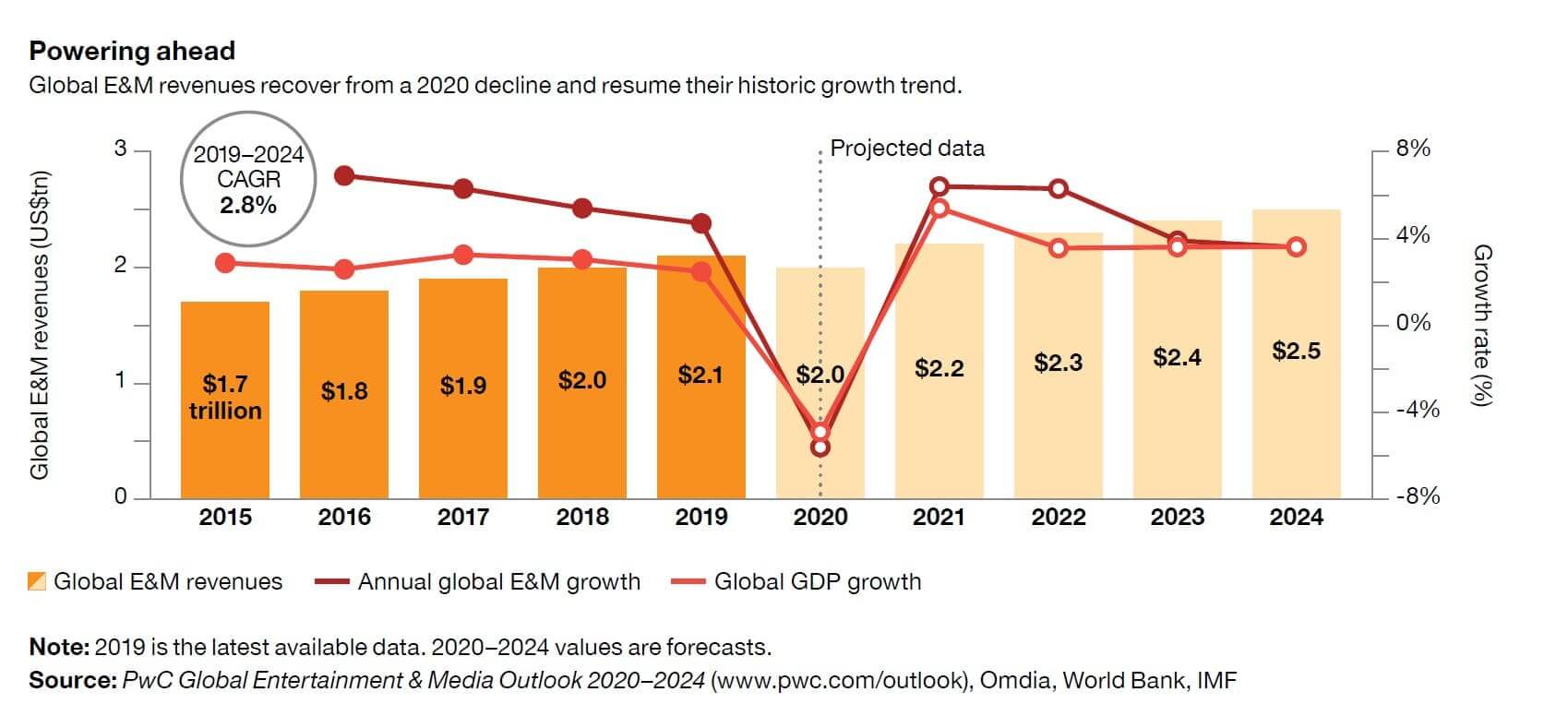
Figure 1 | Source: PwC Pulling the future forward
IDATE has a similar message with its latest World TV and Video Market report: linear TV and OTT revenues will grow slightly worldwide. That’s only a very slight recovery but after the contraction of 2020, who can complain.
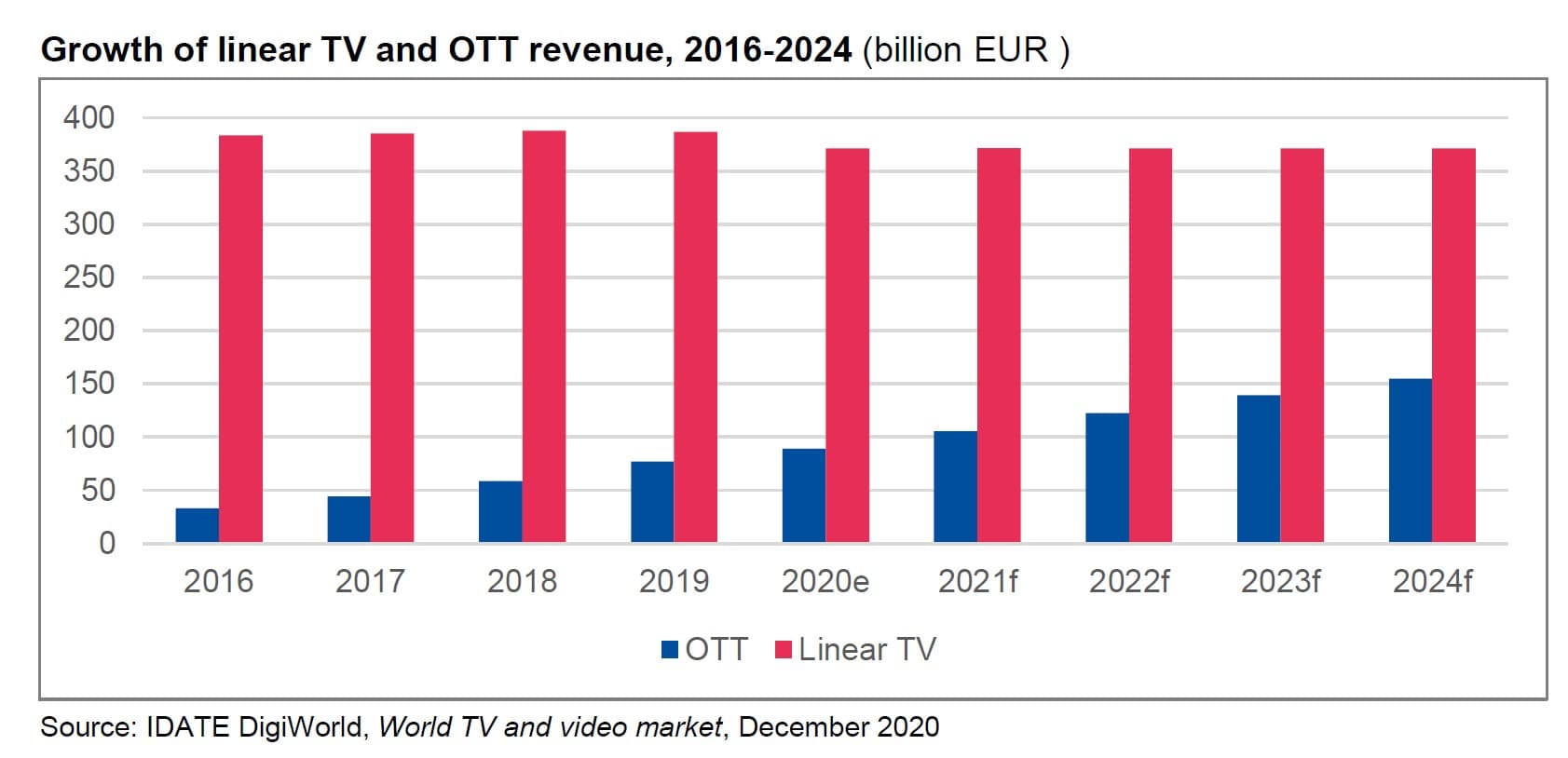
Figure 2 | Source: IDATE
Of course, the recovery, if there really is one, won’t go at the same pace in every region, but we’ll come back to that.
Content and consumption
2. Content Ubiquity
Content is everywhere. And in 2021, new and creative content will continue to rule our media world. With the new season of every quality series comes new storylines new heroes and new twists. There’ll be loads more content everyday across 2021.
Warner’s bold move to distribute its movies in cinemas and via SVOD at the same time could be repeated by other studios. The success – though achieved in a pandemic world – of the initiative with more than half HBO max subscribers watching this recent movie streamed while also setting a pandemic box office record – might give ideas to other.
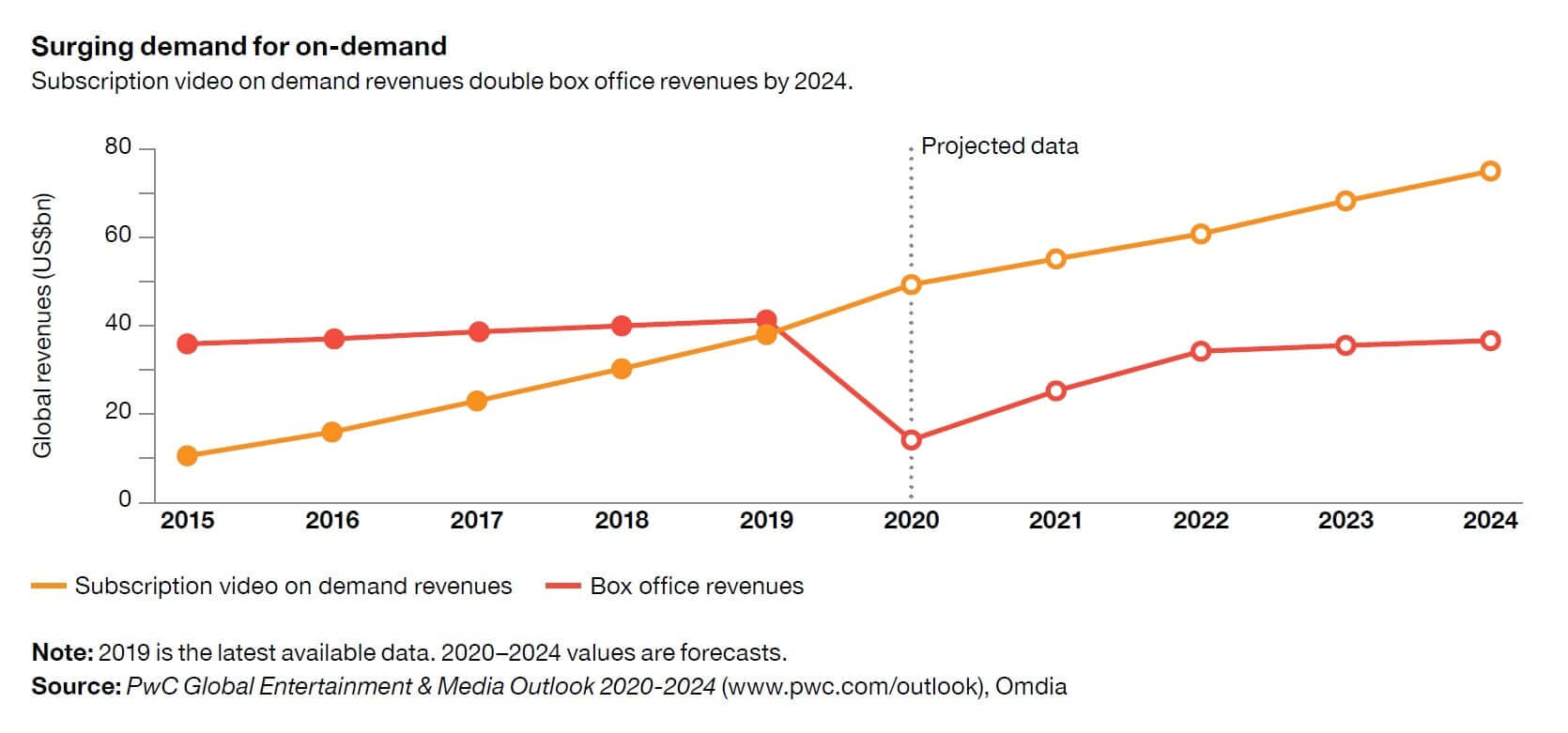
Figure 3 | Source: PwC Pulling the future forward
Also as you can see, 2023 should be the first year – not under lockdown – where US SVOD revenue will surpass the box office. So even if Warner has explained it could change its policy again by 2023, studios have to get the content to where the audience is and it’s way too early to tell how the pandemic will affect things long term.
And it’s not only about SVOD, TV or cinema, it’s also about regional content access: being available worldwide on day one to maximize the impact and benefits. Oh, it’s very 2019 and Game of Thrones finale-related you might say, but where GoT was kind of unique, it’s become normalized by The Mandolorian and The Queens’s Gambit, to mention the latest big hit.
So time will tell how ubiquity evolves but one thing’s for sure: there are many places content needs to be in 2021, starting with the “Flixes”. We’ll explain this right now below.
3. The FAST and the Flixes
Yes, that’s another way to say that, once again, streaming will be trending and that the streaming war is not over. Flixes are services that run the gamut of streaming: SVOD of course with Netflix, Disney+, Prime and Apple+. FAST are Free Ad Supported TV services like Tubi or Pluto TV.
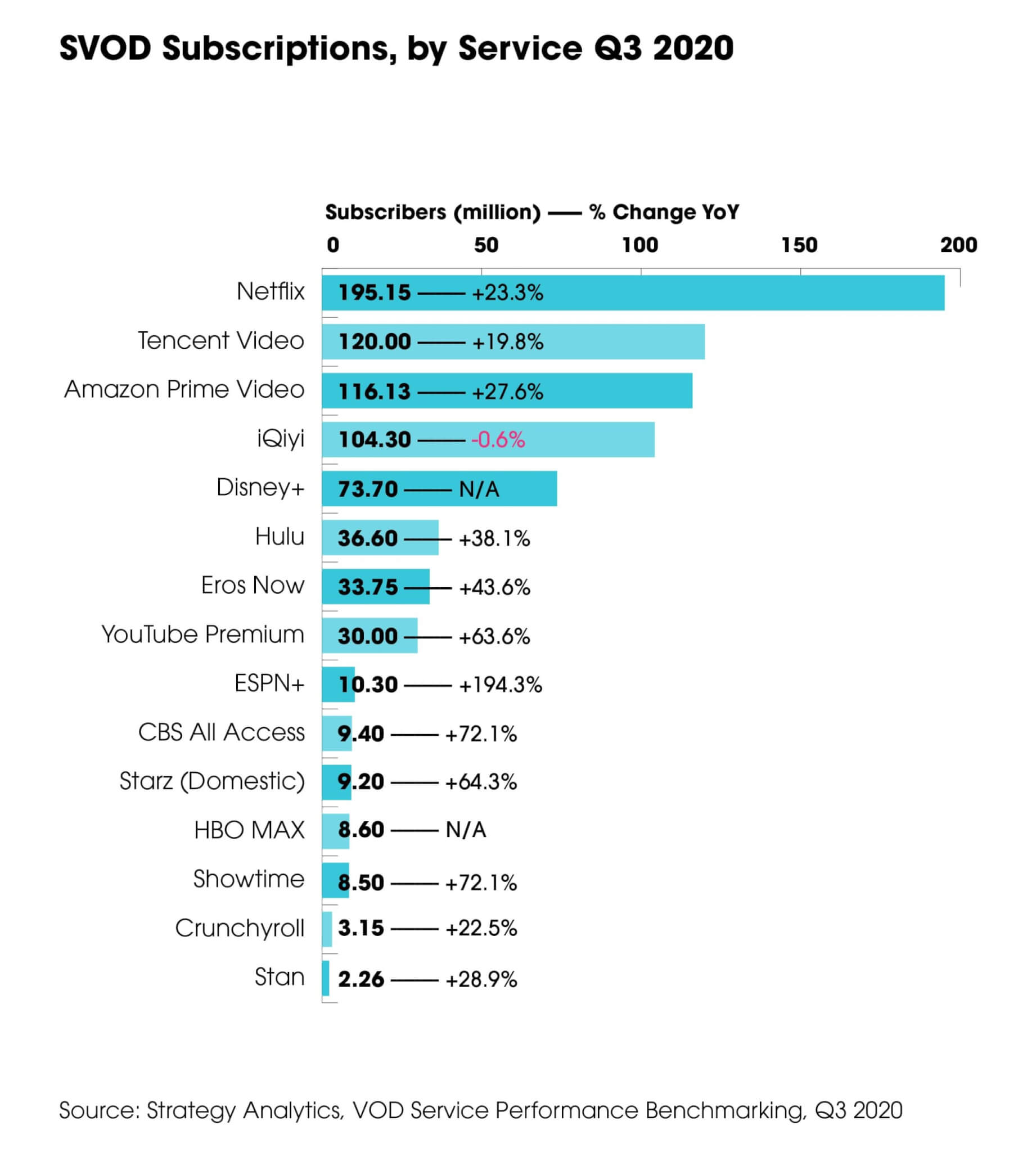
Figure 4 | Source: Strategy Analytics
As you can see, Asia is slowly but surely becoming the dominant continent – that could be a key 2021 trend – and its SVOD numbers are also soaring.
With so many players all over the world, there’ll be competition to be among the surviving flixes: heavy marketing campaigns to get new subscribers or optimizing existing offers to ensure churn figures don’t hit the roof.
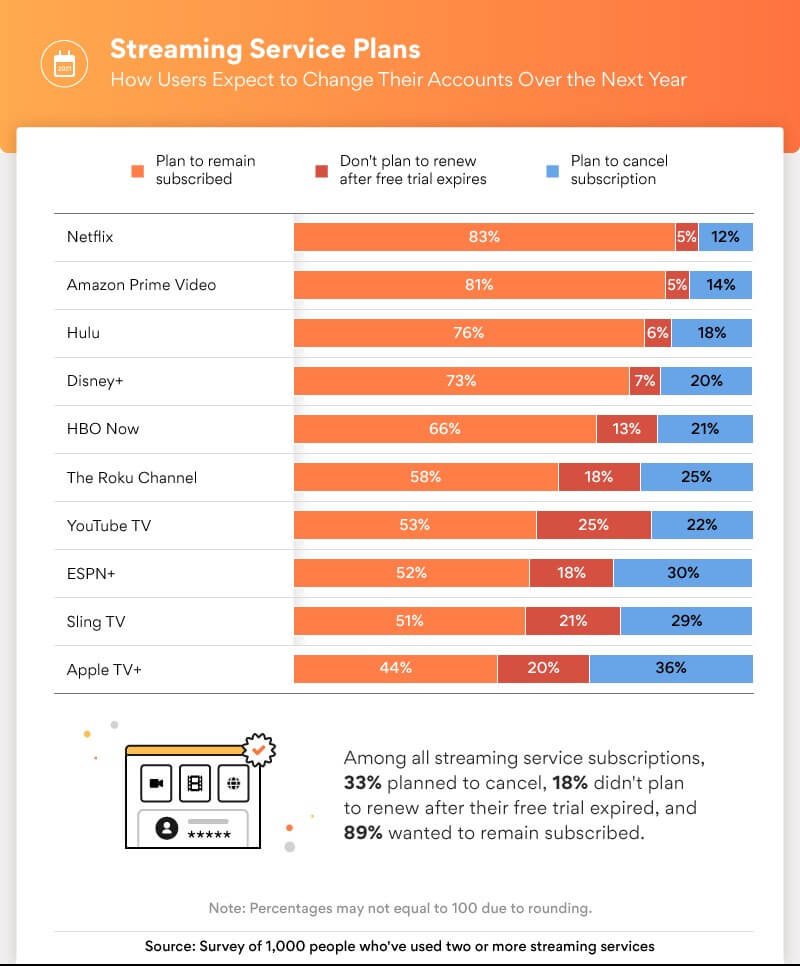
Figure 5 | Source : streaming wars
If you’re a consumer, you might feel a bit lost. How do you find that content that you were so keen on watching? Is navigating to it too complicated? Potentially, but 2021 comes with another great trend to help you!
4. Super Aggregator meets Super Bundle
Last year, we mentioned Content Fatigue as a trend. How more wrong could we have been? Subscription fatigue was also considered and one thing’s for sure: the overwhelming number of offers and content is creating tectonic shifts.
The number of OTT services per subscriber has increased all over the world, but there’s a limit to the number of services to which one wants to, or can afford to, subscribe.
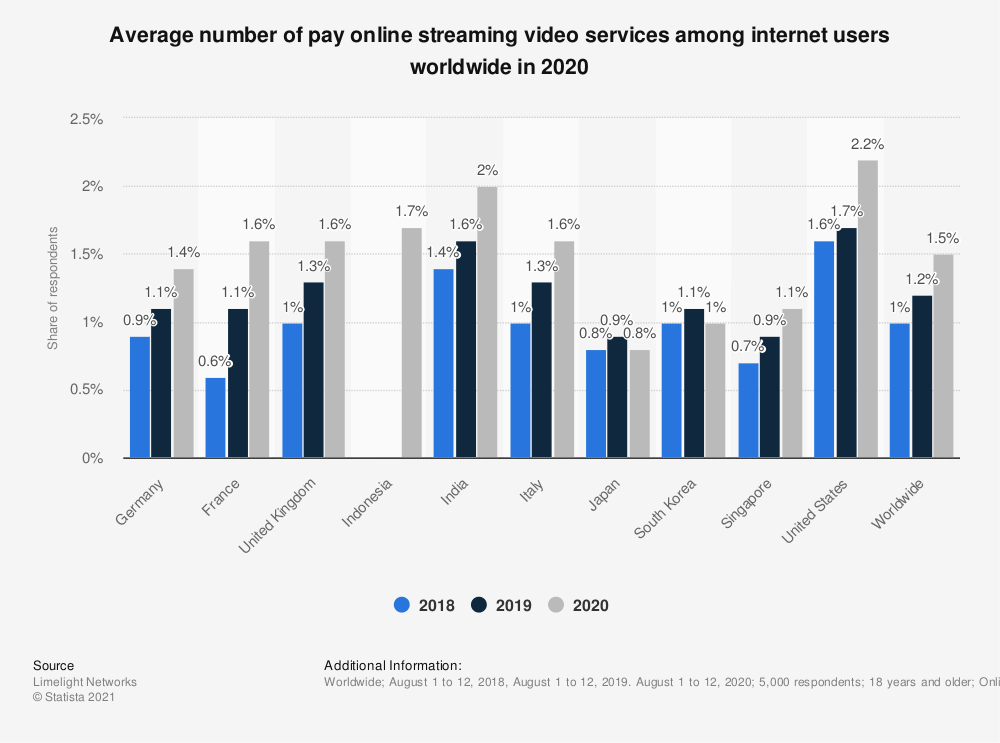
Figure 6 | Source: Limelight Networks
And let’s not forget that it’s happening in a world where pay-TV, though flat or slowly declining depending on the region, is still present in a lot of households. And by “a lot” we mean more than ever
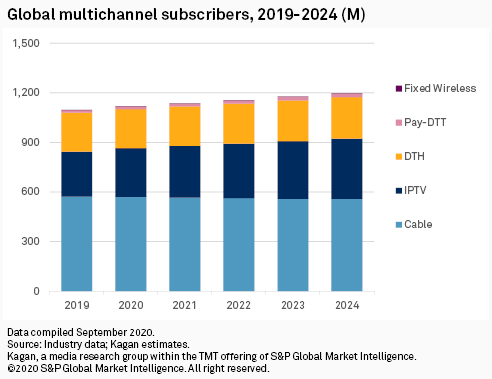
Figure 7 | Source: S&P global intelligence
And streaming will keep growing.
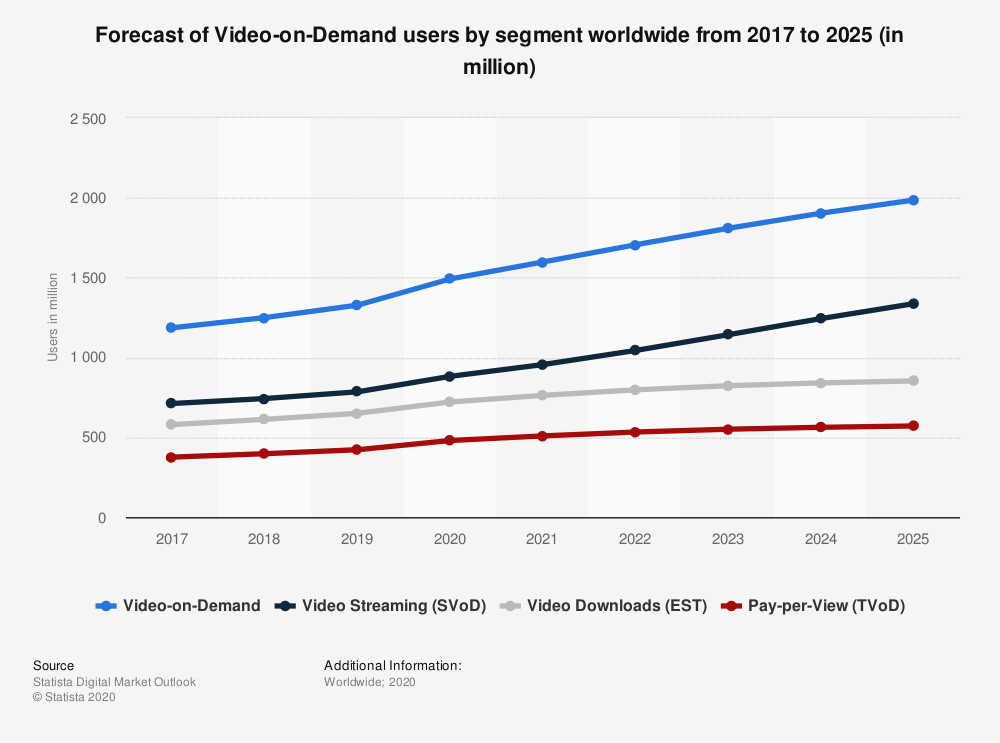
Figure 8 | Source: Statista
More people, more content, more services? That’s really not news, but the trend is the maturing of the super aggregator or super bundle market. What you could call the best of both worlds with better bundles to achieve a win-win situation – that would be good after the lose-lose of 2020.
Bundles are not new, especially the hard bundle: you get Netflix with your Orange Spain subscription; or iQIYI with Starhub for as long as you continue your pay-TV subscription. It’s not new but it’s gaining real traction — from 20 initiatives in 2018 to more than 160 in 2020 (source: Omdia).
But the most interesting new trend relates to the soft bundle. Some telcos are coming up with digital credits that you can assign to your bundle. For example, you pay for 50 credits and you can have Apple TV+, Prime and a niche bouquet and when you’re done watching everything on Apple+, you can use your credits to switch to Disney+.
TDC is one of the few to propose such a competitive offer but Omdia expects this will grow in the future.
If you still have doubts about the bundling:
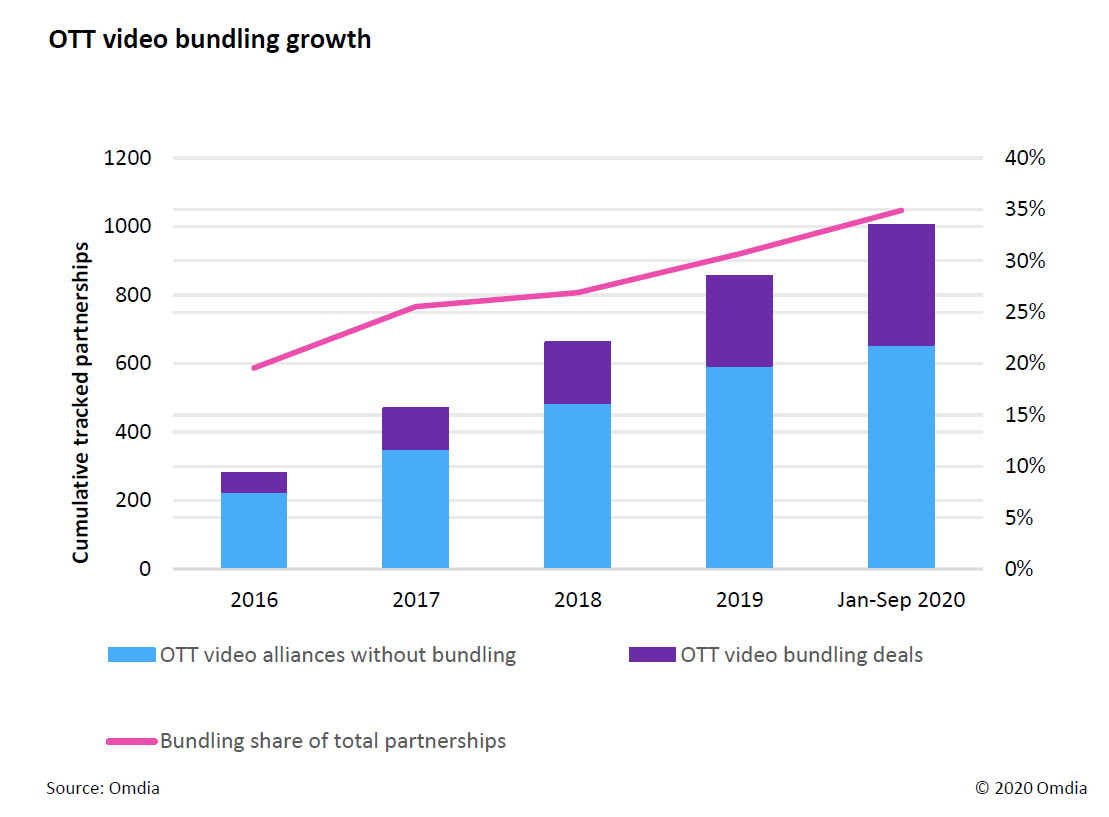
Figure 9 | Source: Omdia
So, is that it? Is it all about bundles and VOD? No, because 2020 was so surprising that it planted some seeds for 2021!
5. Linear TV goes streaming
Who would have thought that linear TV would be trending in 2021? Now, before you toss your iPad or cancel your subscription to Netflix, yes, linear TV will trend but not as it used to.
Let’s not even mention the impressive ratings that linear TV had in 2020. We certainly don’t want to live a 2021 in lockdown. And even if ratings were good, the revenue was not. So let’s not anticipate a full lockdown effect in 2021.
One way linear is coming back is by the “re-linearisation” of on-demand content.
Take Pluto TV and its hundreds of channels: the service was bought by Viacom in 2018. Tivo has recently added 72 channels on its platform while Pluto TV has expanded to more than 100 channels in the UK. It launched in Brazil in December 2020 and its success keeps growing. Not to mention that Pluto TV’s CEO joined Viacom CBS Streaming as CEO in October! Not impressed with Pluto TV’s figures? Well then have a look at Xumo’s.
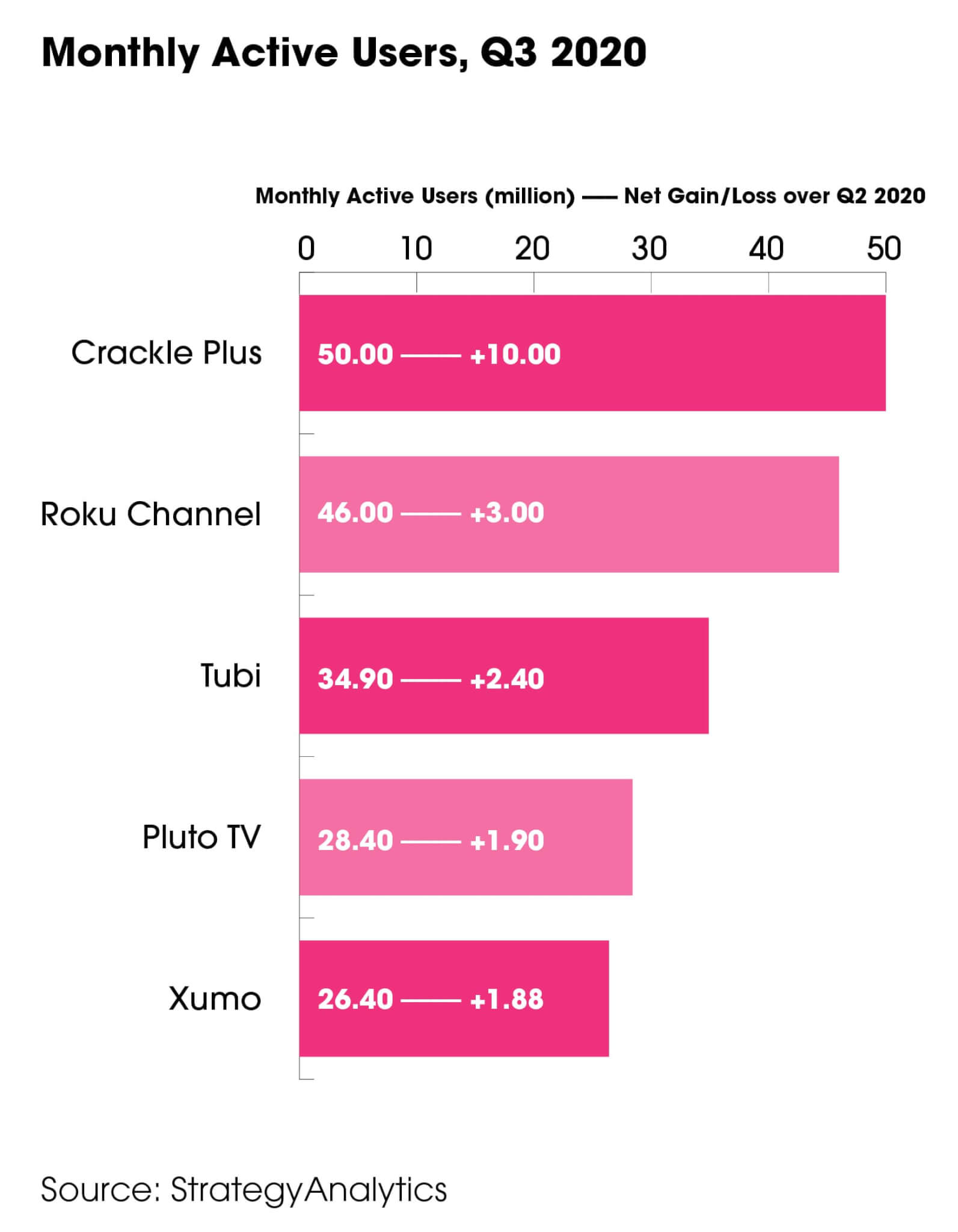
Figure 11 | Source: Strategy Analytics
But you could argue that’s it’s not going to be so in 2021.
What we might possibly see in 2021 is new linear TV services launched by big players that are entering the linear TV market for the first time, like GAFAM and Netflix.
“Netflix is trialing linear programming in France” where “many viewers like the idea of programming that avoids having to choose what to watch.” It’s a web-browser feature only right now but it could roll out everywhere if successful.
Amazon prime is actually hiring people with skills in linear TV so…
6. Co-viewing at Social Distance
Another behavior that we saw in 2020 and is here to stay – despite what happens with Covid-19 – is co-viewing. Co-viewing, as defined by Nielsen, refers to people in the same household watching the same content at the same time but not always in the same room or on the same device.
In 2020 in the US it peaked at a mere 50% during the hardest period of the lock down
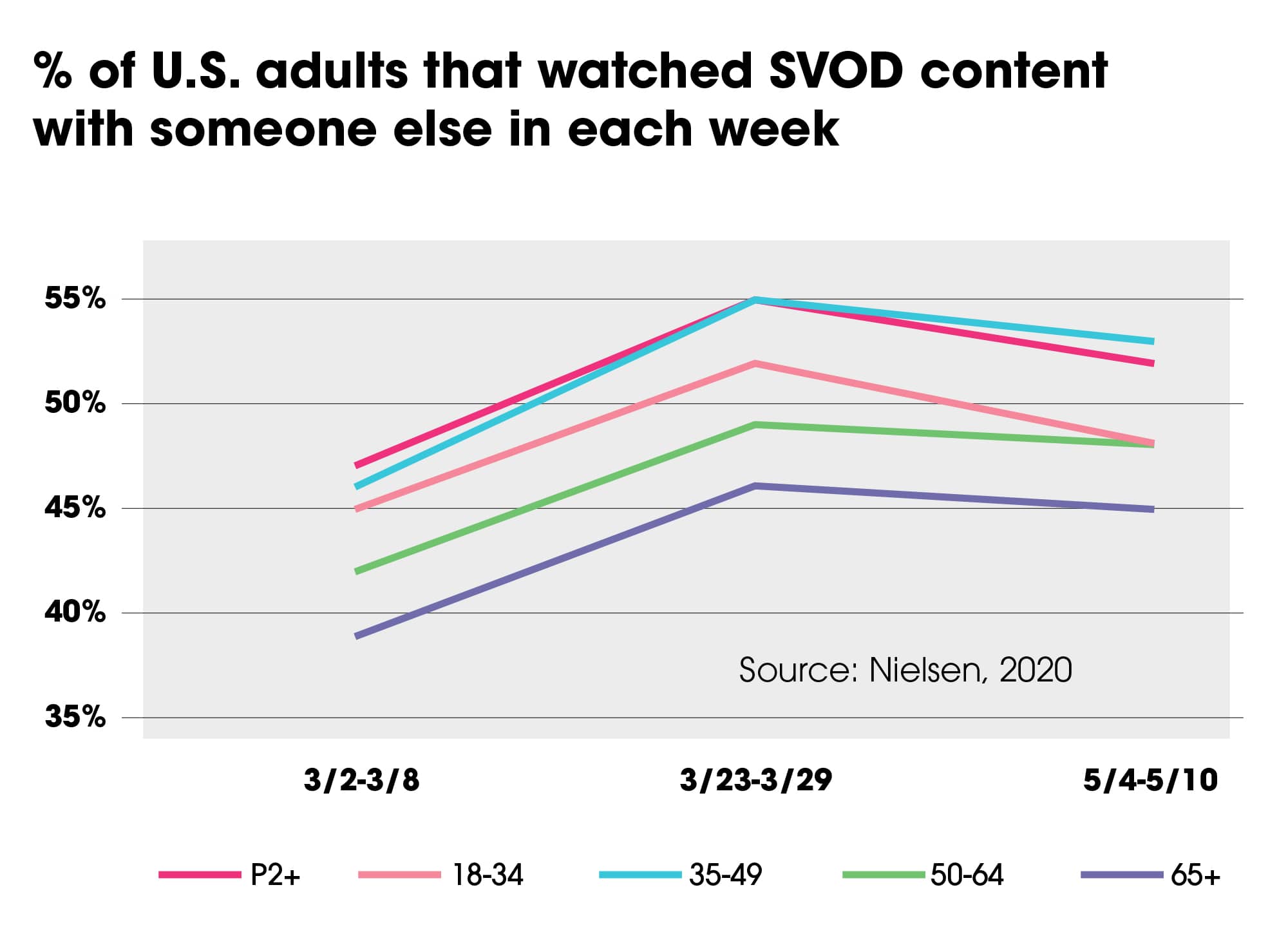
Figure 12 | Source : nscreenmedia
In October 2020, Disney+ announced the GroupWatch feature, which lets you watch any show on Disney+ with your friends and family virtually through the app. Seven people can watch content together. Hulu and Sling have announced similar features, and this type of viewing has been available with Netflix via its Teleparty feature since March — though the streaming giant hasn’t released an official plan.
This is another form of appointment TV in a digital world and puts emphasis on second-screen opportunities, like HBO Max’s latest Halloween campaign that prompted viewers to stream Halloween classics together. It brings people together when social distancing keeps them isolated, as Richard Yo rightly said in his article about co-viewing.
Sports
What content needs recovery the most? What better content to co-watch? What kind of content is fueling pay-TV and potentially SVOD? And what better content is there to watch live! As you know, sport is at the heart of existing trends but of course, it has its own specific possibilities and positioning. And 2020 has been a rollercoaster for the media and sports industry. From total lockdown, to Olympics cancellation to the comeback of the NFL and the NBA, for example, and the steady rise of eSports, the year delivered its load of surprises, and a last-minute break. Now, what’s cooking for 2021?
7. D2C does Sports
Direct to consumer (D2C) reach is on everybody’s lips and since the launch of Disney+, you can’t avoid it. Do you remember how it all started? By cord cutting. And therein lies the question: what if sports fans cut the cord?
Many players are ready for D2C sports growth and in that respect, the main, fairly recent, new player is DAZN, the OTT subscription sports streaming platform. We won’t list all the contracts that they announced in 2020 – a very difficult year for sport to say the least – but 2020 proved to be a solid growth period for DAZN and now the service is available in 200 countries!
Amazon is not far behind and initiated live sports coverage with Premier League soccer in the UK.
Not to forget the large federations that may well be ready to move platforms, from the giants like the NBA and the NFL that already have steady offers to the smallest player.
And not to mention that Facebook has been acquiring sports rights for a long time.
And ESPN does not intend to sit by idly; it has invested heavily in ESPN+.
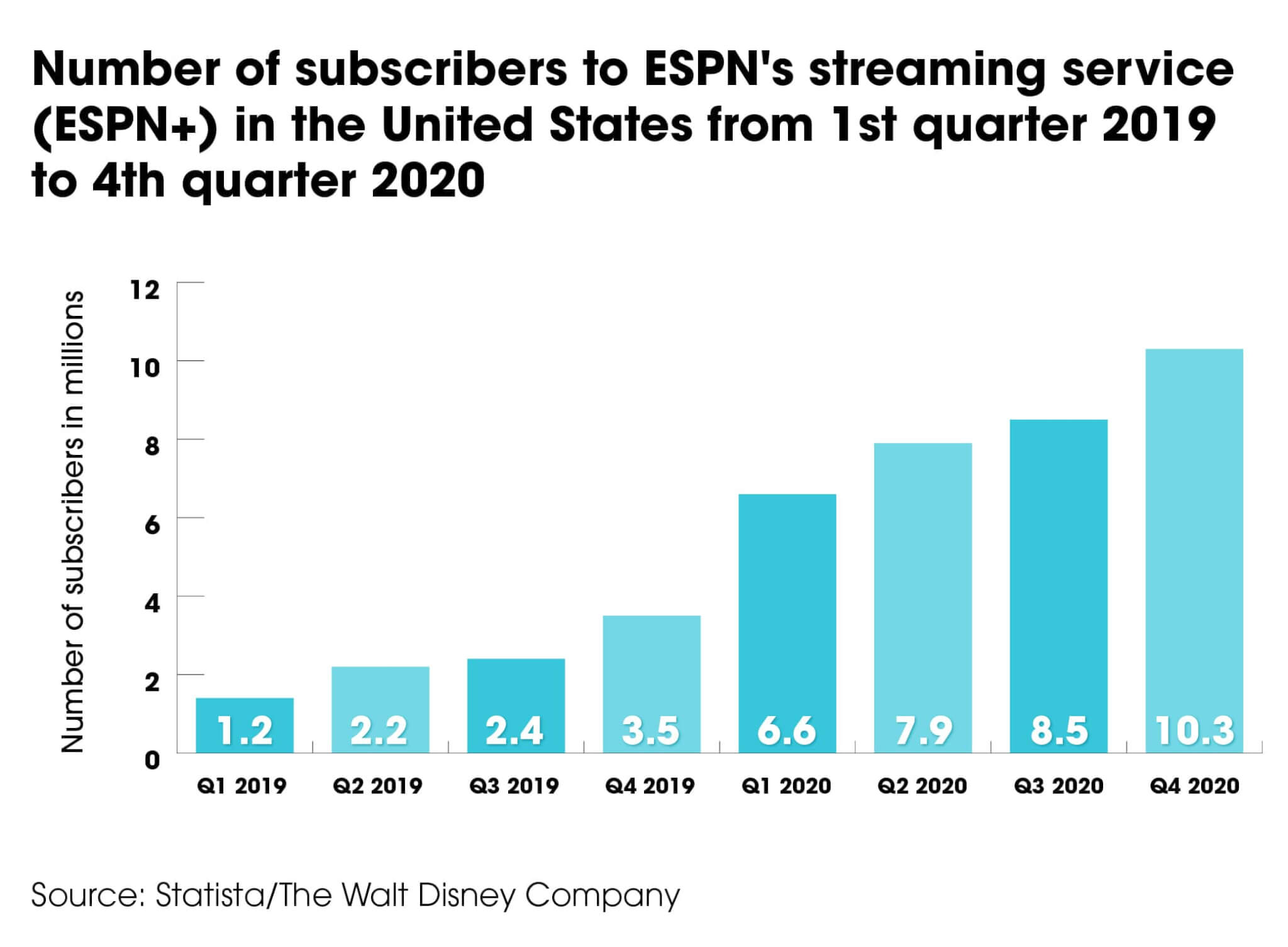
Figure 13 | Source: The Walt Disney Company
Sports accounts for a large segment of the market and we can only expect it to get bigger!
2021 will be a year of more D2C switching but what about the business model for the sports rights themselves?
8. Sport as a Service?
The global value of sports media rights – $44.6bn in 2020 – has fallen by just over 12 per cent from 2019, according to Sport Business Global but it should see growth in 2021 and onward.
Behind those big numbers lies a bleak truth: sports rights are increasing while sports audiences are declining. But 90% of sports viewers are pay-TV subscribers, compared to only 67% of non-viewers and they also bring an incredible ARPU ($84 vs 11$ for Netflix). And even as Two Circles remind us in this report that pay-TV is crisis-resilient, there’s a lot on its plate.
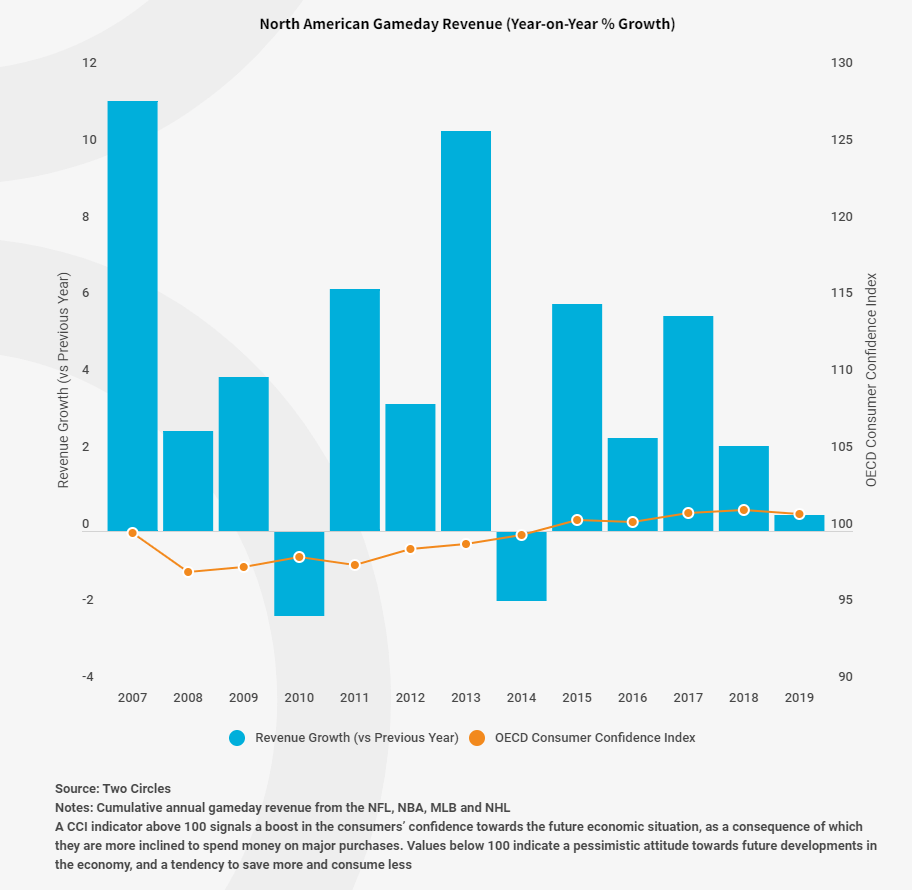
Figure 14 |Source: Two Circles
Another thing we’re seeing is Sports-as-a-Service, which is an attempt by the sports broadcast industry to converge live-event TV with streamed content to attract new audiences. The NBA created a D2C platform with Microsoft and is working with its existing partners, Warner and Disney, rather than going to dozens of broadcasters.
With this shift, one thing remains the same: sports are often at the leading edge of innovation, especially when it comes to video, social media and anything related to fan engagement.
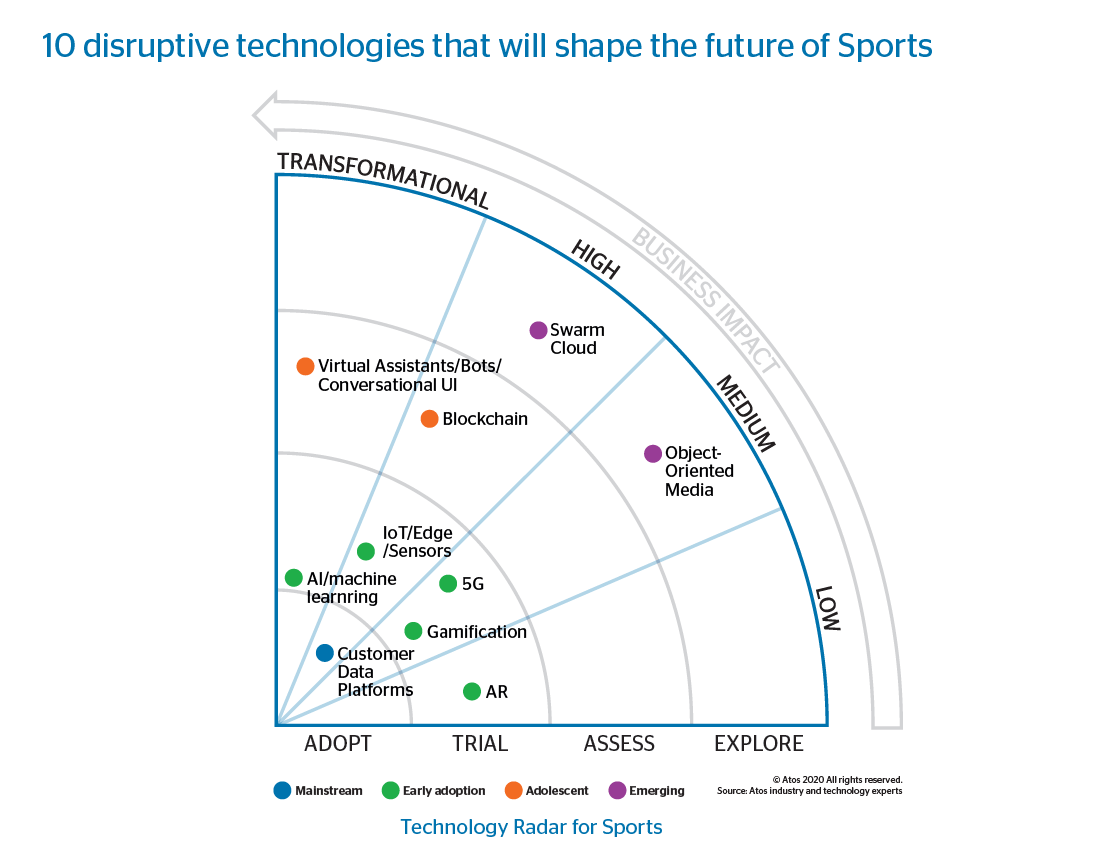
Figure 15 | Source: Atos
9. Hybrid Production – the new remote
Remote production is another trend that has been accelerated by Covid-19, continuing to grow across 2021. According to the IABM it’s the most important technology for live news and no doubt it’s not far behind when it comes to sports.
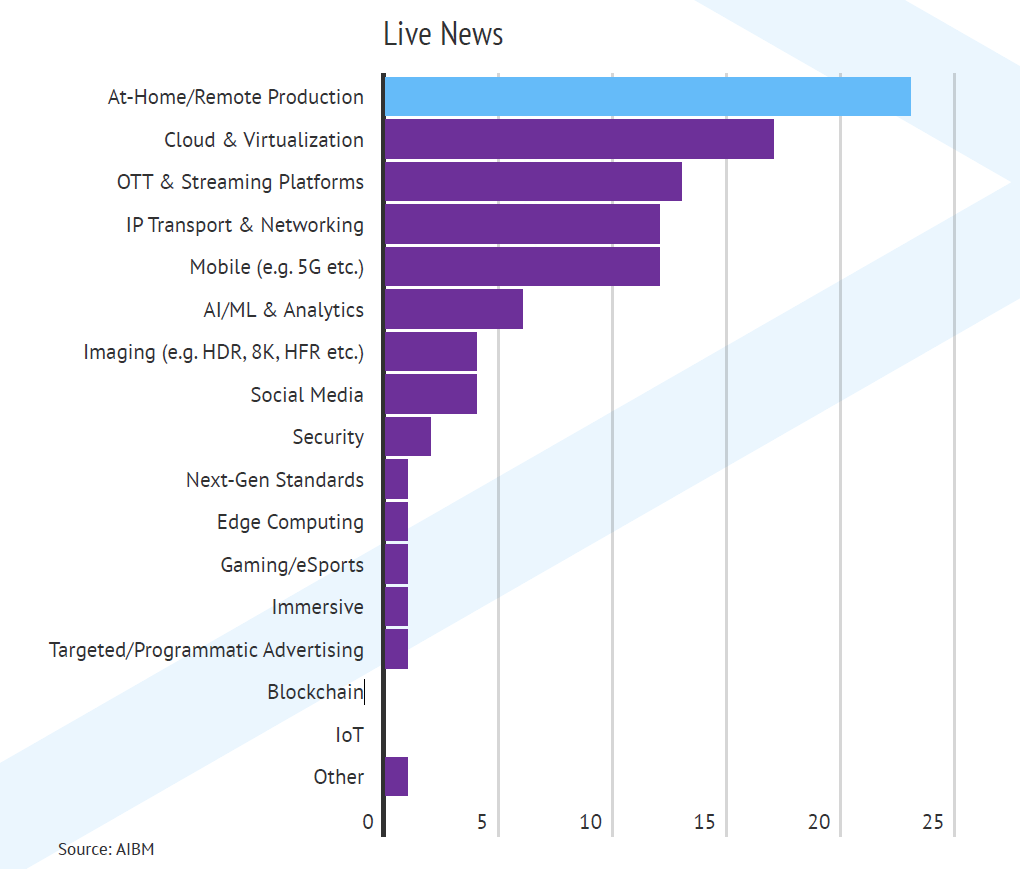
Figure 16 | IABM live news report
In 2020, there wasn’t much of a choice: it was “remote or nothing” and 2021 should be more or less the same. Remote production is not about sports only but sports is at the heart of its progress. BT Sport for example, among others, created a full remote production within three weeks.
At Globecast, we offer remote production and we’ve known for quite a while that it was more about the finance than the technology. Remote production hasn’t always been the best solution for every event or every configuration. But the onset of COVID definitely changed that.
So, the situation now calls for more remote production. According to Omdia, “37% of media enterprises are set to embrace remote production on IP. The remote production market will be close to $3 billion globally by 2024. Although IP will be the fastest emerging delivery route, fiber and satellite will be core to embracing a hybrid value proposition to enhance reliability.”
Everybody is on the starting blocks. Camera suppliers, for example, have not been sleeping with Sony and Panasonic announcing many upgrades to their remote production capabilities.
But as Omdia says: “Remote production is a highly complex and fragmented ecosystem. Therefore, building a niche partner ecosystem across the value chain is essential to not only strengthen footprint across newer markets, but also to improve customer retention rates.”
So as 2021 will bring about even more new ways of doing things, the new normal should trend toward hybrid production to get the best of everything: IP, SMPTE 21, and a mix of satellite, fiber, 4G and 5G. The best mix will win out on each occasion. Or as Liz Mc Parland said, .it’s time to rise to the challenge of the new era of live sports.
Let’s move to the next topic: 5G
10. 5G in production
As far as “media and technology” is concerned, 5G holds dual interest for us: though the pandemic has affected the ability to correctly price certain services or drive proper revenue from them, monetizing 5G is already happening. 5G and OTT are a match and should reach $1bn of revenue says OMDIA, 15% of that with 4G and 3G bundling.
We’re referring to the consumer side here and, of course, we’ll be talking about 5G all year.
But let’s focus on the production side, mainly how 5G will impact the way we create and distribute content. In other words, 5G broadcast. And here a lot should be happening in 2021.
First, telcos will connect to sports venues where it makes sense for them, maybe based on the contract they already have, to avoid data contention for users and to allow proper production uplinks. Telefónica announced that it has installed a dedicated 5G network in The Abanca-Riazor Stadium, home of the football Real Club Deportivo in Spain. Verizon did it in 2019 in the US and Orange started it in Marseille in France.
Outside of the stadium, broadcasters are also planning to use 5G but they are more dependent on Telcos for this. 4G was a “better than nothing” technology for contribution, it was so-so for SD, and it wasn’t very reliable for HD unless you used good IP-bonding. 5G should change broadcast distribution from top to bottom with many use cases.
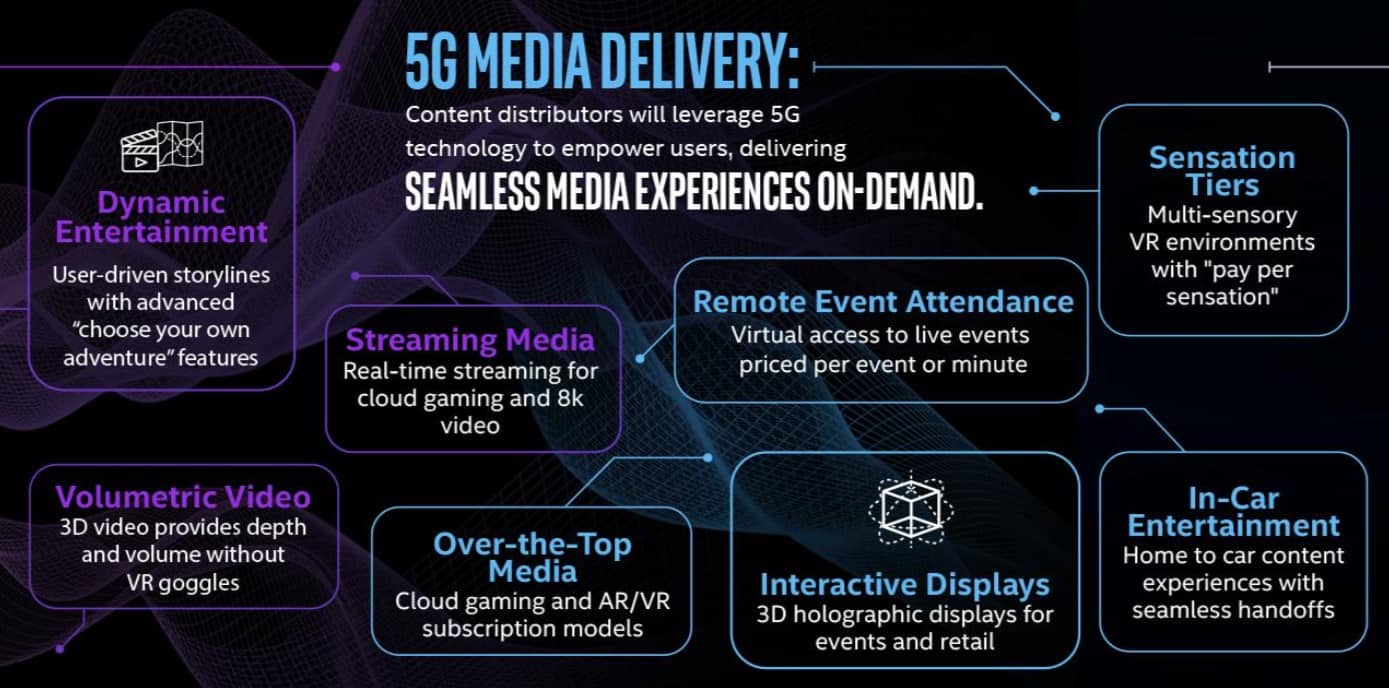
Figure 17 | Source: Intel
As COVID accelerated the 5G discussion, you can expect a lot on that subject in 2021.
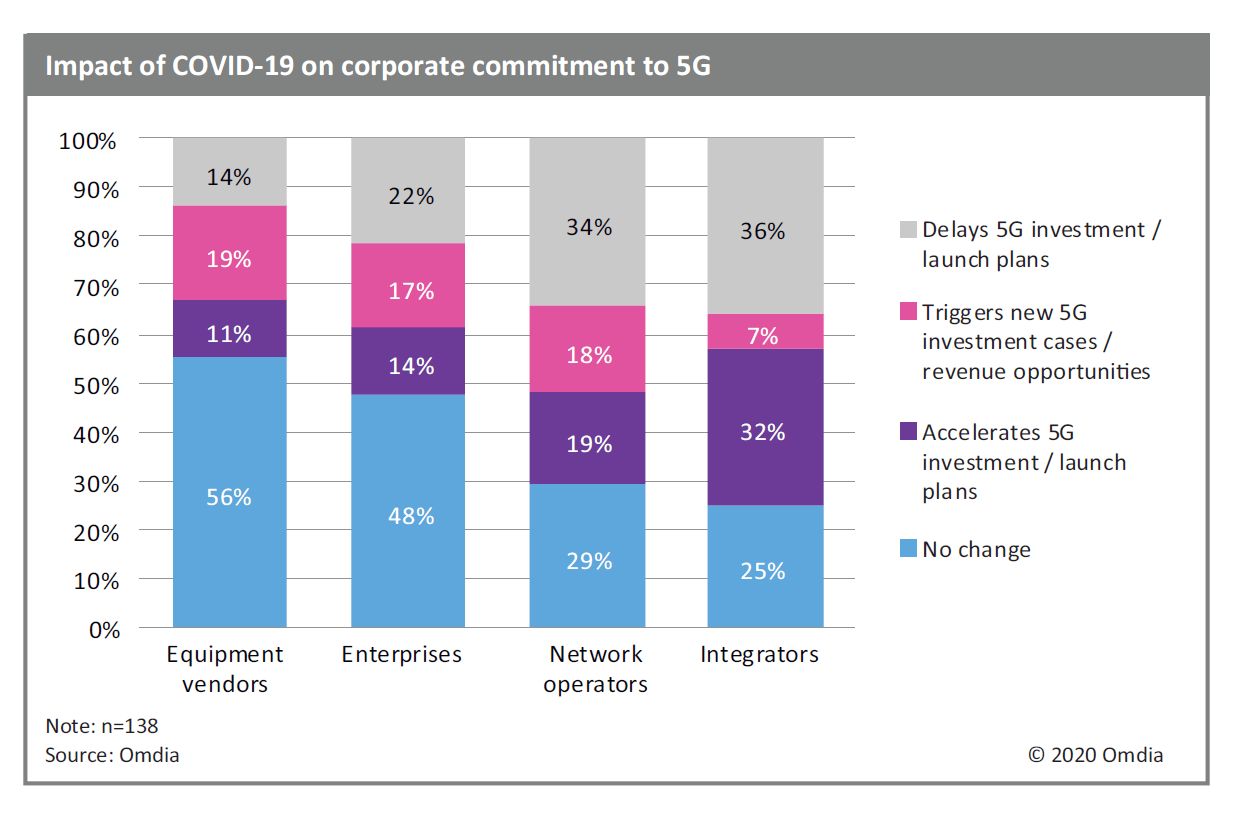
Figure 18 | Source: Omdia
We’ll come back on it. During the Olympics maybe…
Video trends
We can’t discuss trends in media and video without mentioning images themselves and the technology that makes them possible. We simply can’t. No, we really can’t.
11. The 4K/8K world
Of course, image and sound quality are topics that will be discussed all year long, so let’s have a look at where we stand in terms of UHD – both 4K and 8K.
4K is getting real and being deployed with 190 services online according to the Ultra HD forum. When it comes to imagery, HDR is pretty important so out of those 190 services, 40 are HDR10 and 52 are HLG.
But what about 8K? According to the Ultra HD forum, there are less than 10 services and trials – and that includes YouTube and Nasa.
Did we mention that it was an Olympics year and that 2022 Beijing is also in the queue? China Unicom has a lot of plan with 8K including Flat 8K, VR and multi-angle perspective content.
And of course, NHK has plans for Tokyo 2021 with its BS8K channel – in fact, NHK also has plans for 8K cameras for Mars but that’s another story.
On the device side, sales have started. Deloitte predicts that 8K television sales will generate £2.5 billion globally in 2021. And it should increase steadily over the coming years.
Of course, if you work in that subsector, you know it’s not only about the device – TV, consoles, PC, smartphones, etc. – it’s about the entire value chain: from cameras, through production, transport and storage to distribution. In that regard, the industry is not ready to move from 4K to 8K says Thierry Fautier, vice president of Video Strategy at Harmonic. And though NHK will broadcast some 8K content for Tokyo, the portfolio of content stays very limited.
Again, according to Deloitte: “The lack of native 8K content is not likely to be a major issue for consumers contemplating 8K sets. All 4K is readily upscaled to 8K using AI capabilities on the TV set, and there is now ample 4K content via on-demand and broadcast platforms.”
In the never-ending race of improved quality content, there is a critical element that is not to be underestimated — codecs. Let’s discuss them now.
12. The Codecs world
The famous Al Pacino quote in The Godfather III works perfectly well with the codec war: “Just as I thought I was out, they pull me back in”.
Let’s have a look at the latest annual Bitmovin report about video.
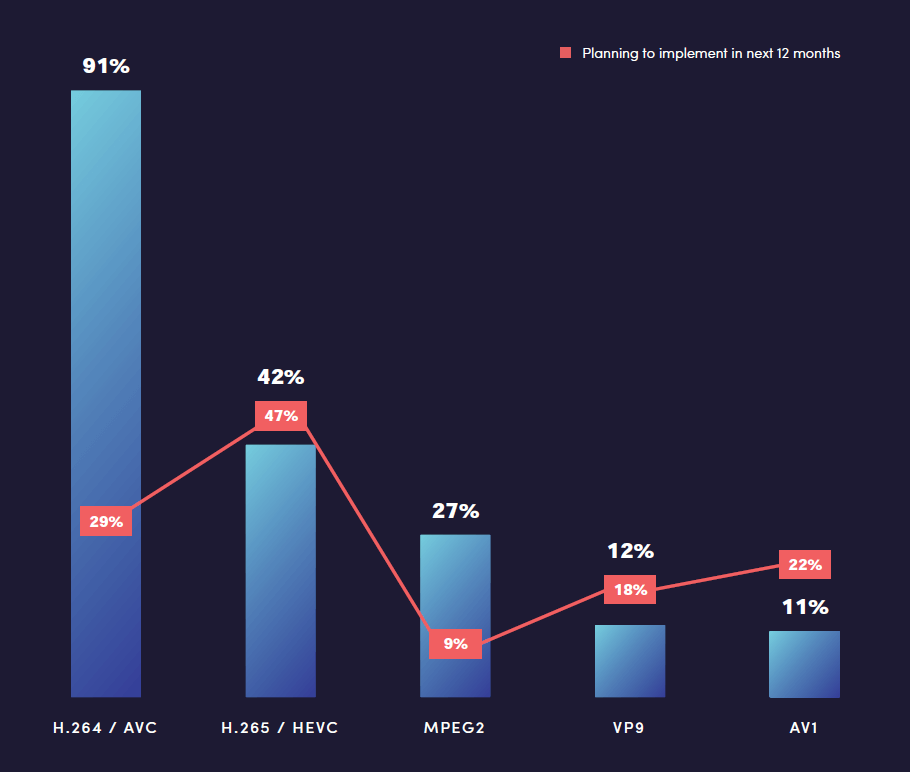
Figure 19 – Which Video Codec are you using? | Source: Bitmovin
It seems to be business as usual, one could say. AV1, VP9 and HEVC are slowly gaining traction. But as they are useful from many perspectives, including cost reduction, bandwidth saving, and quality improvement, codecs are generating a lot of interest and driving innovation.
So as soon as the industry sees a new opportunity, it heavily invests in it. The pandemic might have impacted that too.
In 2021, MPEG will launch four new codecs alone including LCEVC already in the pipe, while VC-6 has just been validated as an SMPTE standard.
We know that as far as CODECs are concerned, can take time to spread across the industry and can prove unsuccessful if not properly handled (read this superb article by Jan Ozer for more about the best ways to fail with codecs.) So you don’t want to be the last to realize there are new things happening. 2021 is likely another video codec war year.
Acquisition and Delivery trends
So, we have consumers willing to consume more video; we have live sports ready to innovate; we have quality video with 4K or 8K and we have proper codecs to make them viable. Now what? We make sure it’s properly acquired and delivered!
13. Bye RTMP, welcome SRT Streaming
If you’ve been in the business long enough, you might have started in a world where RTMP was the main protocol when it comes to acquiring/ingesting a video signal.
If you’re somewhat new to the industry, then welcome. You’re entering a world where RTMP is still the main protocol when it comes to acquiring and ingesting a video signal.
Just kidding; the dominant ingest protocol is now HLS but clearly, RTMP has been incredibly resilient.
The fact that it showed good latency – at the time – must explain its resiliency.
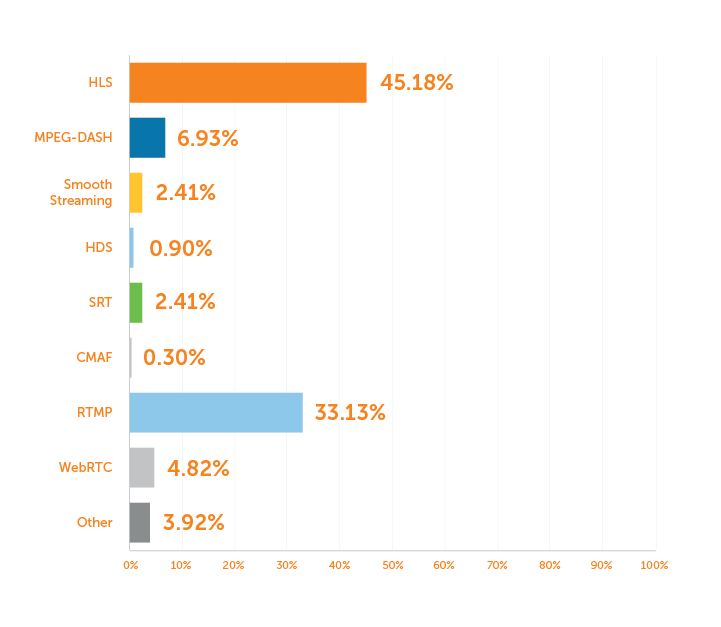
Figure 20 – Which streaming formats are you currently using? | Source: Wowza
But COVID might finally have got to it! SRT is an open-source streaming protocol that is codec-agnostic, has low latency and allows high-quality video.
It appeared in 2018 and could have slowly grown, but the pandemic gave it a boost.
It’s mostly used for the first mile – and we know that the first mile can be challenging – but there were use cases that required a little bit longer “first mile” during the pandemic. And in that respect, SRT is way better than RTMP. It even led to SRT being renamed the SOS protocol.
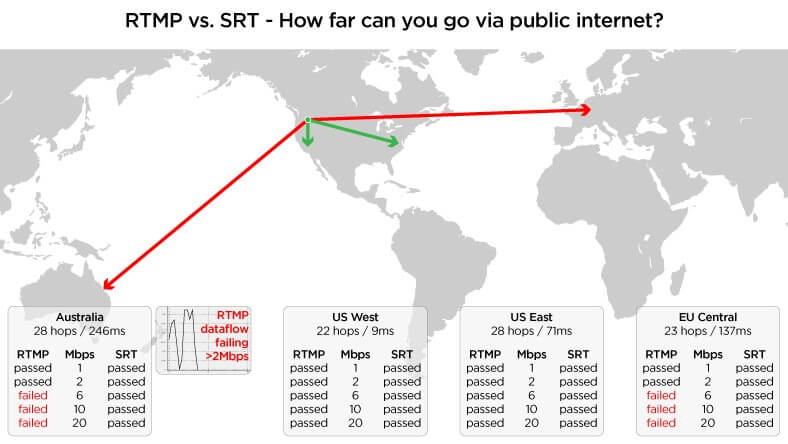
Figure 21 | Source : haivision
That’s good for the ingest but what about delivery? There’s a lot to it in 2021 too.
14. CDN everywhere
Are CDNs trending in 2021? Really? Yes, really!
First, a CDN is mandatory for many services and uses related to OTT:
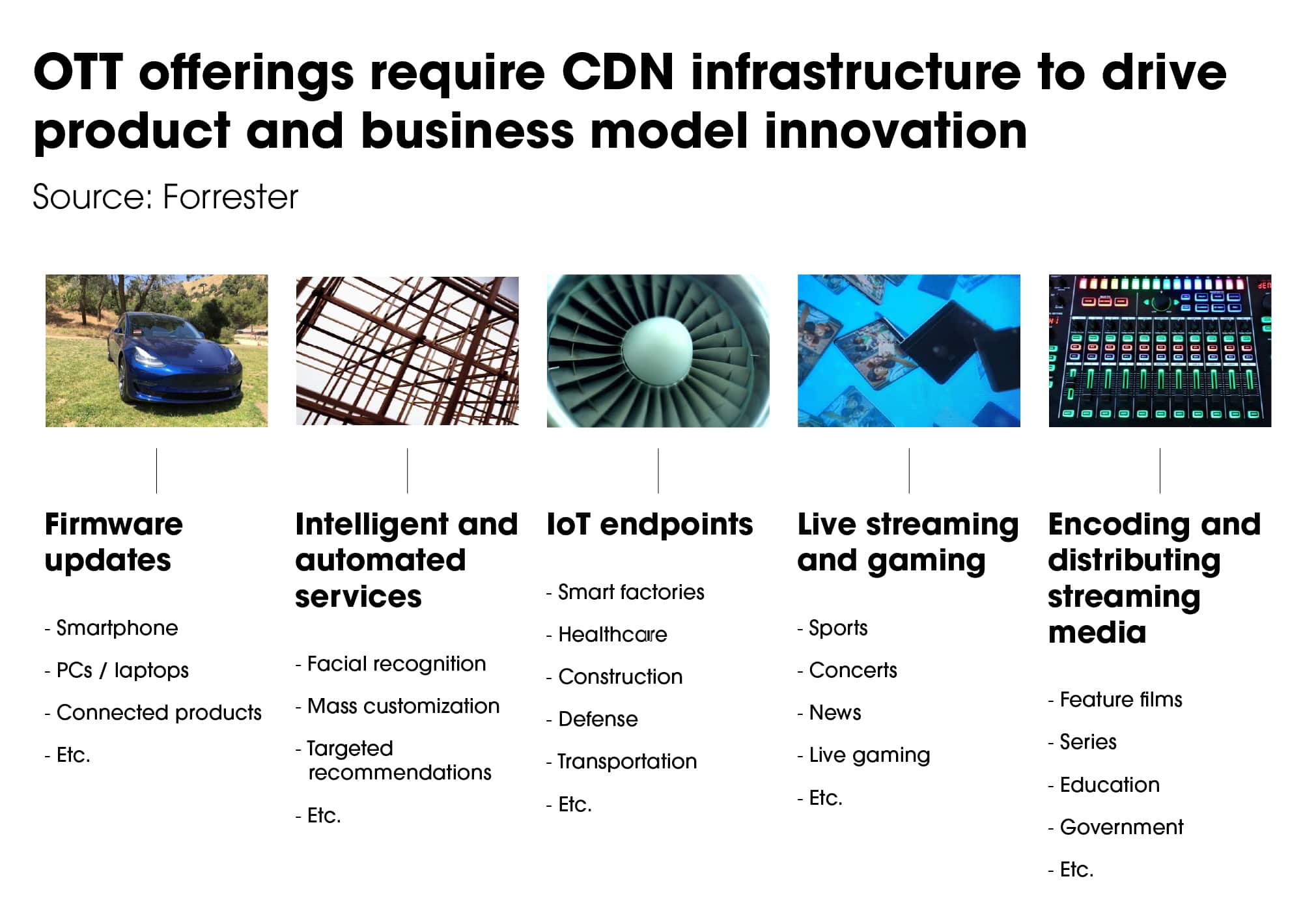
Figure 22 | Source: Forrester report for Orange
Secondly, video consumption is drastically increasing, and whether it’s SD, HD or 4K, live or VOD, if you want to have improved quality at a lower cost, you need a better CDN.
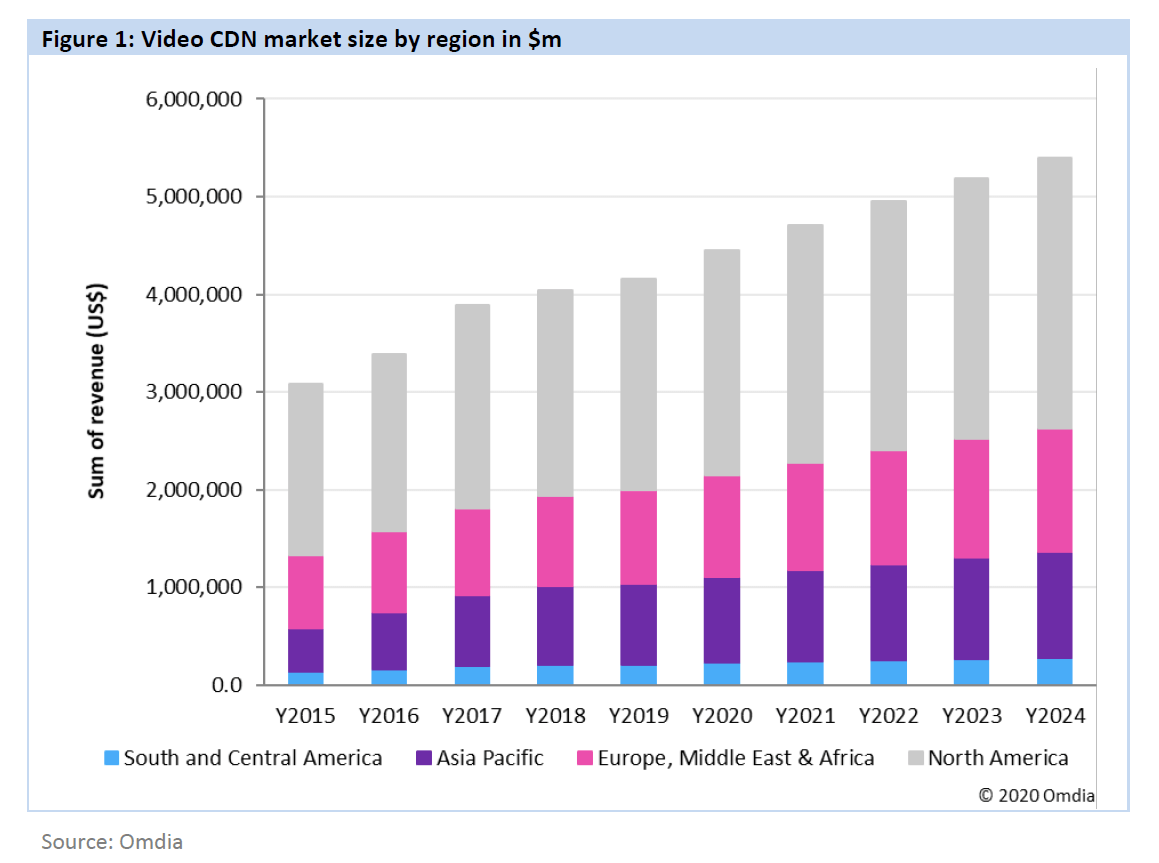
Figure 23 | source : Omdia
If you need a refresher on CDNs, we suggest reading through the OTT series from the Broadcast Bridge including Evolving CDNs to improve OTT.
And if we look at Asia – and it’s good to look at Asia for innovation — 5G, OTT, live streaming, IoT, the next generation CDN is already there.
So, all over the world we’ll get better CDNs but this is not enough. We will also need Multi CDN, which is a method that uses multiple CDNs from different providers at the same time. This method is becoming common in the US, Europe and Asia but there‘s a lot to do worldwide. Multi CDN is very important to improve the quality of regular streaming, and it’s vital when it comes to lives sports, for example – for things like inserting stats and when low latency is an issue.
And last but not least, the open framework WebRTC will keep growing. You could say that WebRTC is the equivalent of SRT but on the delivery side. Why is that? Because WebRTC helps achieve low latency, which is our next trend!
15. OTT : ultra low latency
With SRT streaming for acquisition, WebRTC for distribution, multi CDN, efficient codecs and 5G spreading, we’re good to go with ultra-low latency.
OK, it’s a bit more complicated but it doesn’t change the fact that ultra-low latency will become more than required in 2021.
First let’s make sure we’re on the same page regarding what latency is:
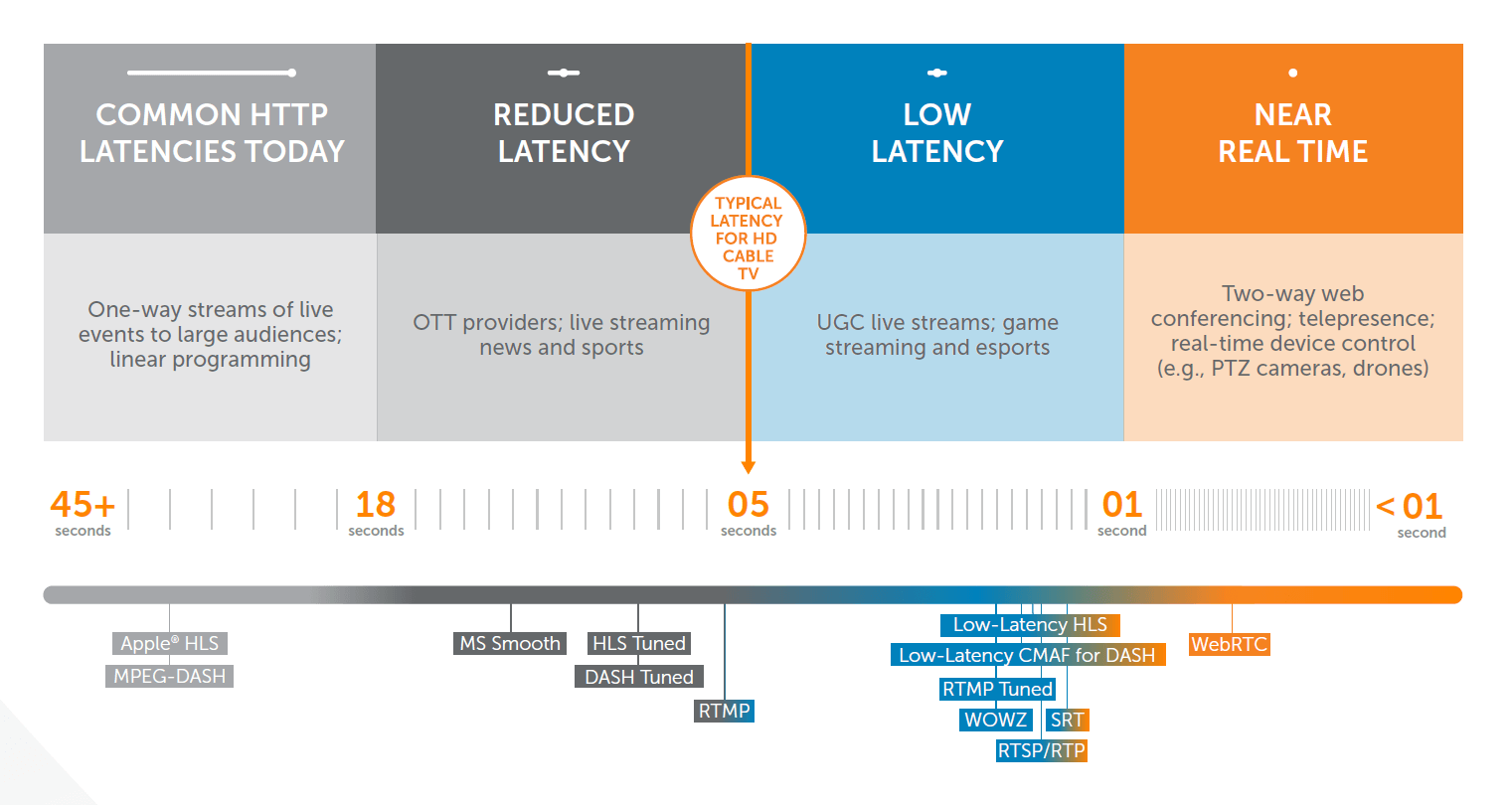
Figure 24 | Source: wowza
Now, regarding the importance of latency, there are many reasons or use cases:
– Live sports are switching from traditional pay-TV to OTT models
– eSports keep rising and cloud gaming is starting to ramp up
– AR, VR and haptic technology are getting real
Ultra-low latency is becoming more important than ever and, that’s good news.
Data, my dear data
You could argue that every piece of audio and video is data, so why a discussion on data? Well, since analog TV isn’t quite dead, not all video is data. But let’s not start 2021 by arguing. So why a specific point on data? Because it’s overwhelming, increasing and bearing promises and threats for the future of our industry.
16. My name is Ad, Targeted Ad
All planets aligned, finally – we might have said the same thing last year but hey, can you blame anyone for not getting 2020 right?
CTV’s (short-form, targeted advertising to relevant content channels) penetration keeps growing as traditional advertising reshuffles with the slow decline of pay-TV and new players like Netflix joining non-traditional linear TV and AVOD still on the rise. With this, 2021 should be the year of fully targeted ads.
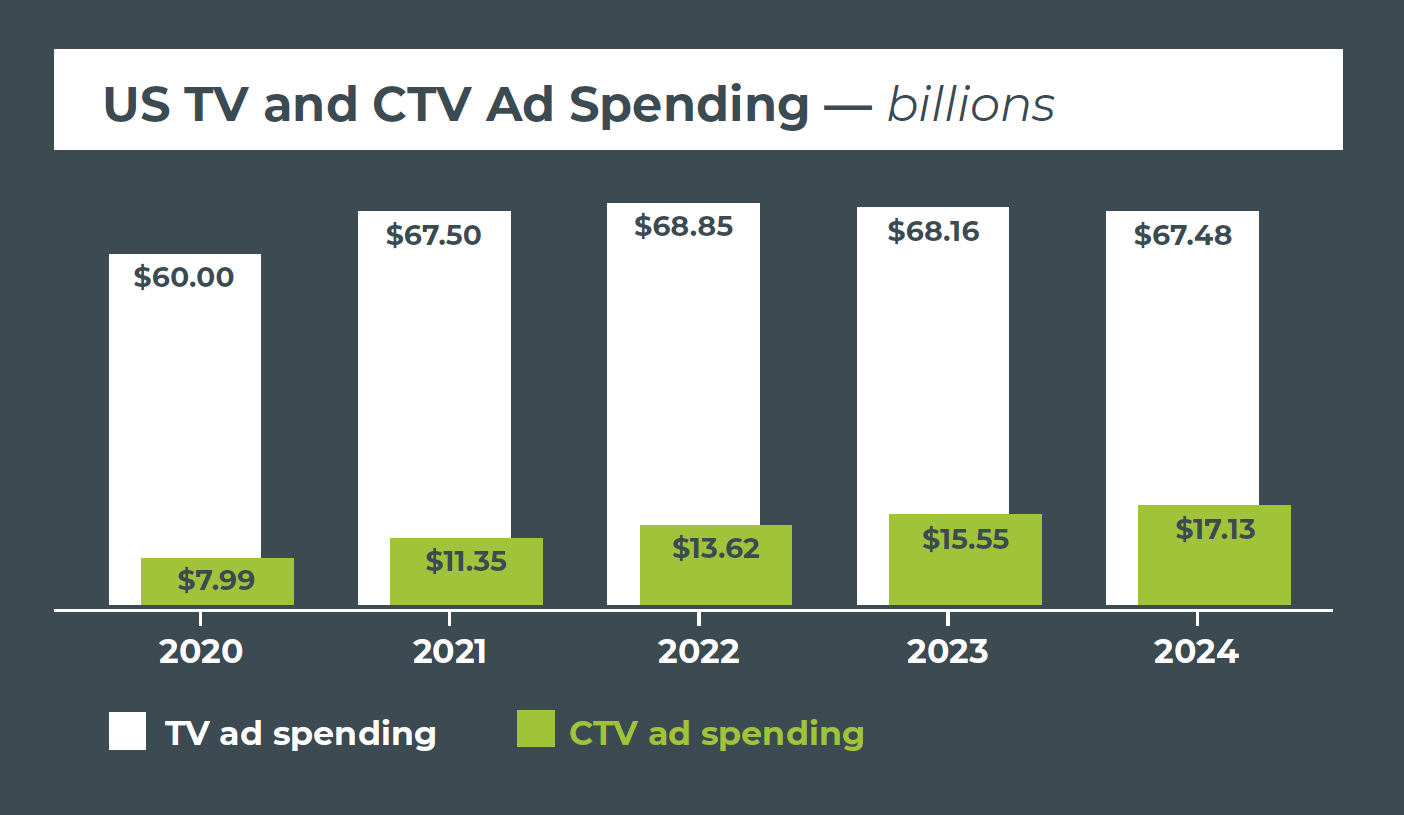
Figure 25 | Source: SpotX
And it should be a worldwide trend, not just a US one.
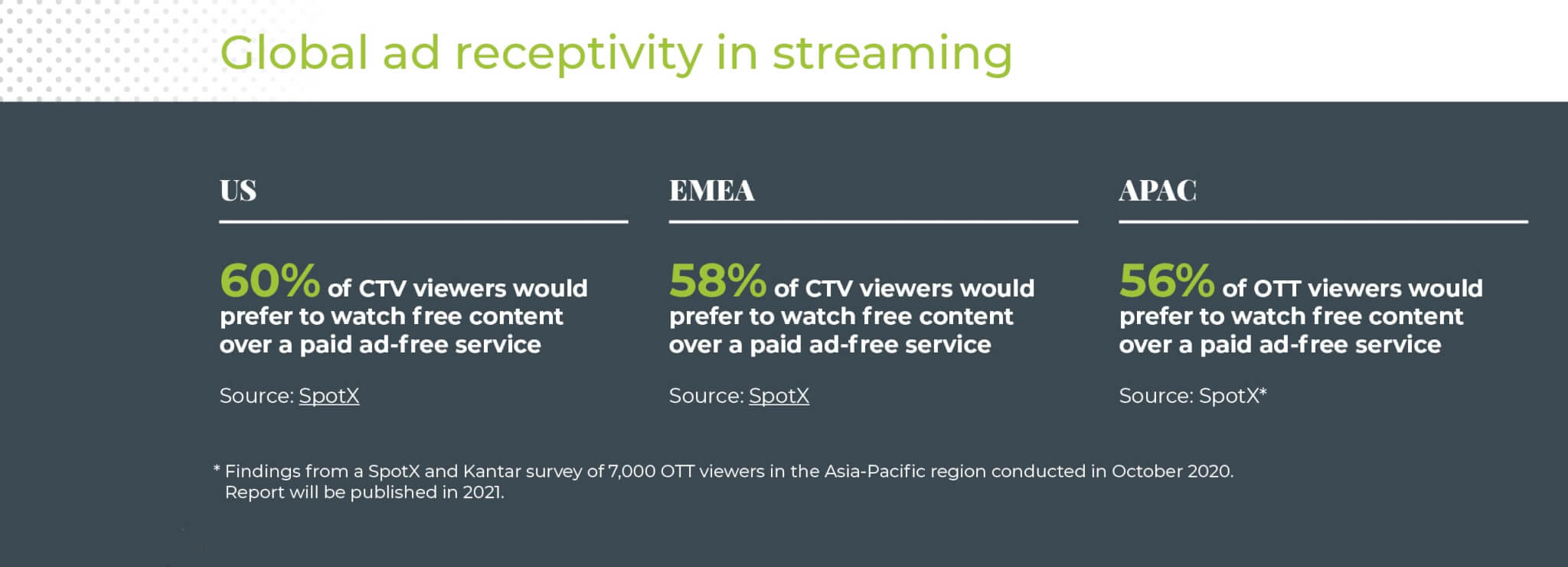
Figure 26 | Source : SpotX
Not convinced? Nielsen mentioned its Three secrets to get addressable TV right and if you’re still not in the mood, why don’t you give us a call on Zoom – we’d be happy to discuss it with you.
17. AI, always AI
The pandemic has accelerated AI adoption. Have a look at the GlobalData AI platform revenue forecast if you have any doubts.
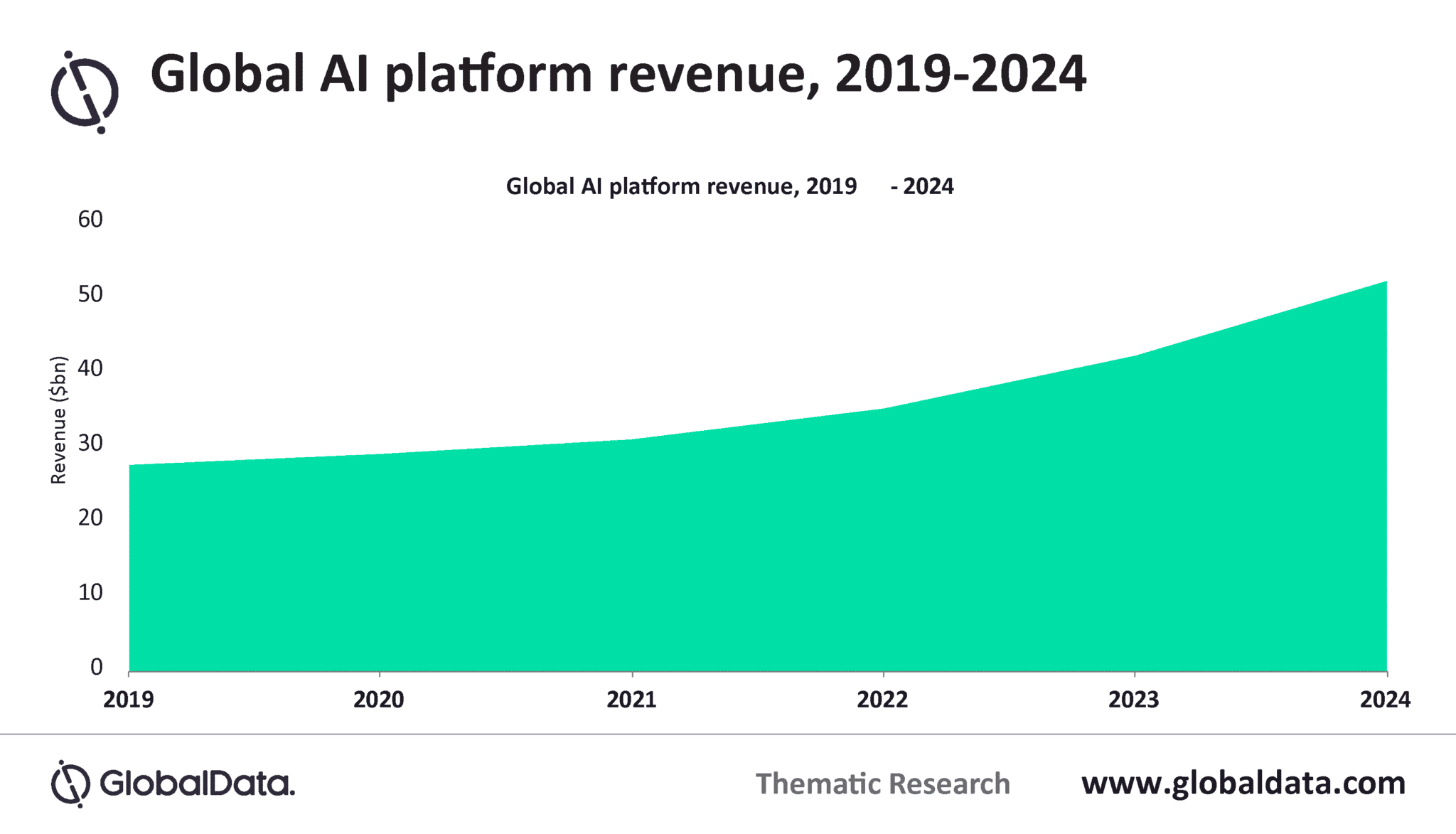
Figure 27 | Source: GlobalData
What about media? When we wrote 10 powerful applications for AI in broadcast two years ago, we pretty much summed it up (let’s brag a bit to start the year.) Not that it hasn’t changed in two years, but what we mentioned back there has expanded and is becomming mainstream: QC, metadata, recommendation, compliance, advertising — it’s all there and everywhere.
But there’s another field that AI is entering: it’s content creation itself. By this we don’t even mean Deepfakes or Fakefaces.
No, we’re talking movies or series.
First have a look at this short movie. It’s setting was written by OpenAI GPT-3.
If you’re not convinced, let’s have a look at sports with an AI solution that allows production with automated cameras.
So, AI will contribute to effective content creation, though there are some that argue that we will always need the human touch to create truly individual content.
And the second way in which it’s influencing content creation is data. Netflix and others base their programs on data and ratings, and AI can help to identify what should be created, by whom and for whom.
This latest tool could even predict the movie rating before one single frame is shot. Is this for the best, though?
18. Cloud goes uncompressed
There was a time when people were scared to use the cloud – everybody now pretends they never were, though. Now it’s scary to be late to the party in terms of using the cloud, as you’ll lose competitive advantage. In fact, nearly everything that’s related to our industry seems to use the cloud somehow.
Native cloud applications, Infrastructure as Code, and cloud microservices are all trends that will accelerate in 2021.
In fact, according to Deloitte quoted in TVBEurope, “Cloud revenues will increase 30 per cent or more between 2021 and 2025 due to three key motivations: cost savings, driving innovation and the quest for agility”.
If we talk video packaging only, on-premise solutions are slowly dying, to be replaced by private, public or hybrid cloud
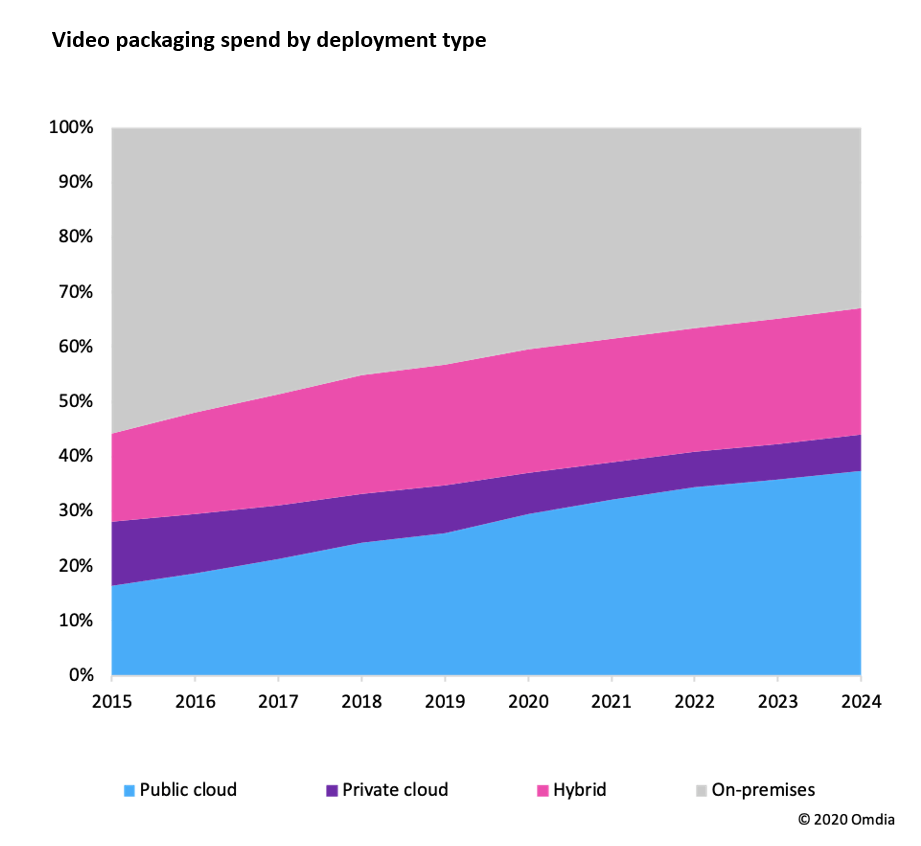
Figure 28 | source : Omdia
Last but not least, the cloud is allowing uncompressed video and that sounds a bit like one more nail in the coffin for SDI: At the end of 2020, AWS introduced an interface for uncompressed video transport live.
19. Cybersecurity under attack
Covid-19 accelerated many technologies or habits that were already on the rise. Hurrah for streaming, eSports and…cybercrime! Yep, 2020 came with more than one deadly virus.
Which means that the number of attacks should triple (across all industries and worldwide). Happy new year!
Then as 5G spreads, IoT will come with loads of new threats that Oxford Economics labelled Internet of Threats.
And because so many of us are remote working, well, your workers can of course be cyber attacked at home. Not new by nature but by size.
Deepfakes will become more of a threat according too…pretty much everyone. It’s simply becoming creepier.
“Earlier this year, a political group in Belgium released a Deepfake video of the Belgian prime minister giving a speech linking Covid-19 to environmental damage and calling for action on climate change.”
And we’re not even mentioning password sharing for SVOD or piracy.
So, is 2021 all about bad news? No! Let’s have a look in Asia again where according to Omdia, the fight against piracy and the new services should pay off:
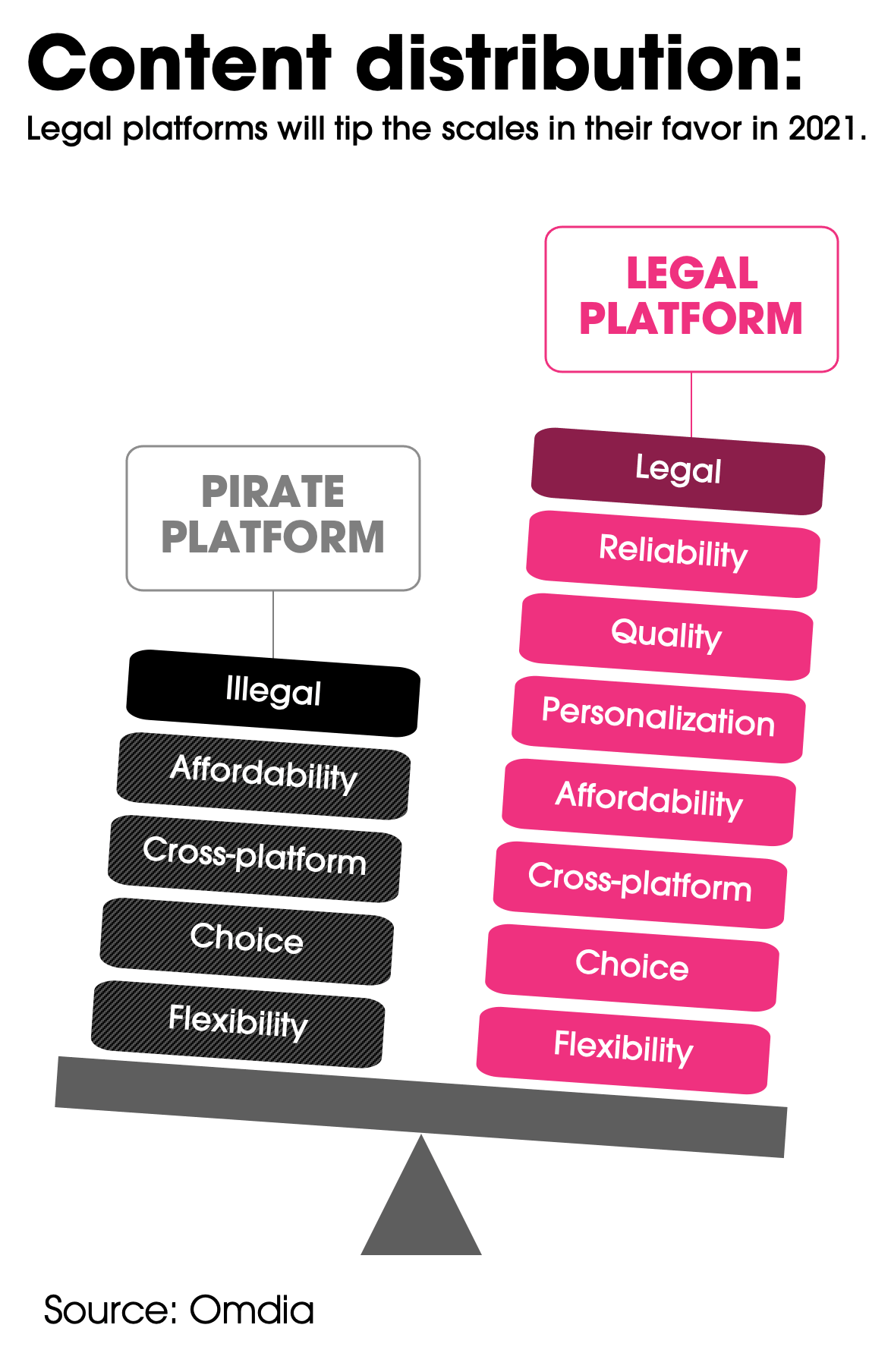
Figure 29 | source: Omdia 2021 Trends to Watch TV and Online Video in Asia Oceania
It’s true that Asia has been kind of finger pointed for years, but it seems that education and government policy – and technology – are starting to pay off as AVIA explainns. But the road will be quite long and we’ll need to stay focused, especially as it’s not about Asia only. Have a look at those figures from Viaccess Orca if you have a doubt.
Last but not least
20. Sustainable by Design
We mentioned this in our 2020 trends blog and unfortunately, we have to include it here too. We suspect it might be included in our 2022 review, and so on.
Two reasons: first, the climate – thanks, Captain Obvious – and more seriously, the fact that our industry is not doing so well in this regard. There are many initiatives yes, but not up to the challenge yet – ok, no industry seems to be up the challenge completely yet.
Here are a few numbers for you:
- One hour of TV produces 14 tons of CO2 according to Albert, the sustainability production body from BAFTA
- Video streaming will represent 79% of all mobile traffic in 2022, accounting for more than 1% of global emissions (Cisco)
- According to the Shift project: streaming content on Netflix for 30 minutes was almost as damaging to the planet as driving four miles with a gasoline car
- It’s getting real: The Global Risk Report by the World Economic Forum is now dominated by the environment with more than 75% of the respondents concerned by extreme heat wave or destruction of natural ecosystem.
- Last but not least, the trend to 8K doesn’t help. According to Interdigital, by ”2023, roughly 30 million 8K TVs will consume 50% more energy than the 343 million tablets worldwide”.
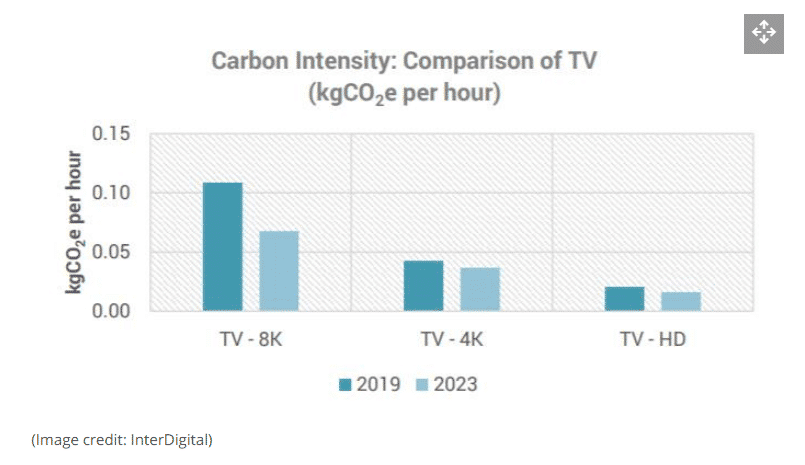
Figure 31 | Source: InterDigital and TVTech
Bluntly put, everything usedto create, produce, manage, distribute and analyse content pollutes. The email sent to start the project, the shooting, the post production, with or without CGI, the distribution via satellite, fiber, IPTV or CDN. And so on.
Until 2020, we could have argued that hey, other sectors were bigger pollution creator than us. And there is always a bigger polluter. In 2021 and moving forward, it’s time to realize that everybody has their part to play and we all have to pull together and do everything we can.
There are more companies that are pledging to become carbon neutral by 2030 or 2035. The Climate Pledge is targeting net zero carbon by 2040 and includes Amazon, ITV, Microsoft and Verizon.
In that respect, the BBC is one of the leaders in this. The BBC recently published two papers about the footprint of distributing radio and TV. For the TV part, one of the most exhaustive papers you can read by a media group and the result come as surprising. Check out the short version here.
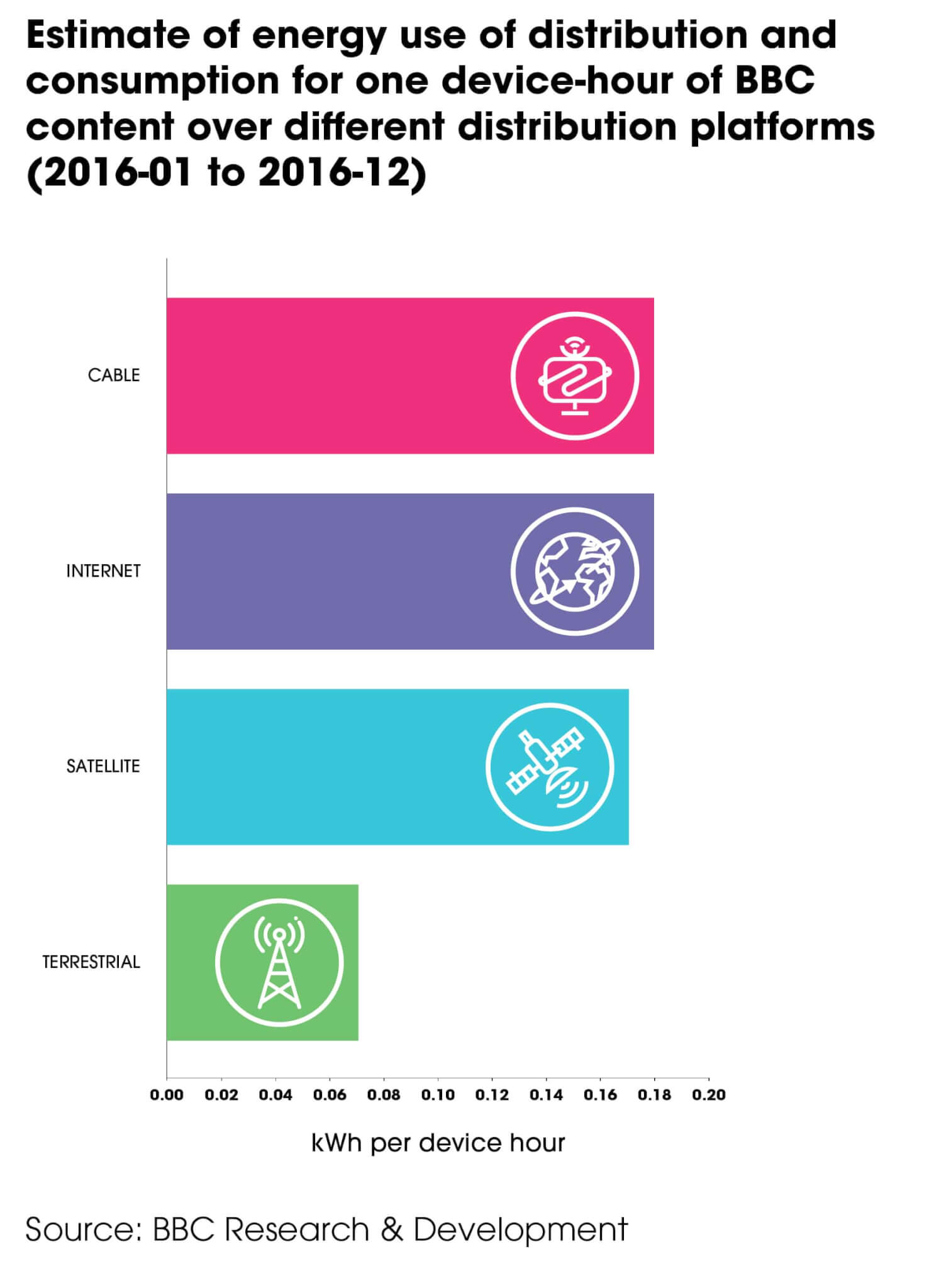
Figure 32 | Source: BBC
If we stay in the UK, ITV has also a proper strategy that includes:
- Selecting suppliers that are clean or committing and with a strategy!
- Using a virtual set when it saves cost and energy.
- Using smalls cars rather than large OB vans
So, there are many items in the agenda to work on, but one thing is for sure: we’re all in this together.
What about you?
That’s it for our trends. We could have added a lot more and you can expect more throughout the year – but it’s all about choice so here it is. If you’ve been paying attention, you’ve noticed there were “only” 20 trends and not 21. So, what about you? Which trend would you have picked to make it 21?
Credit Header Image: Nasa

